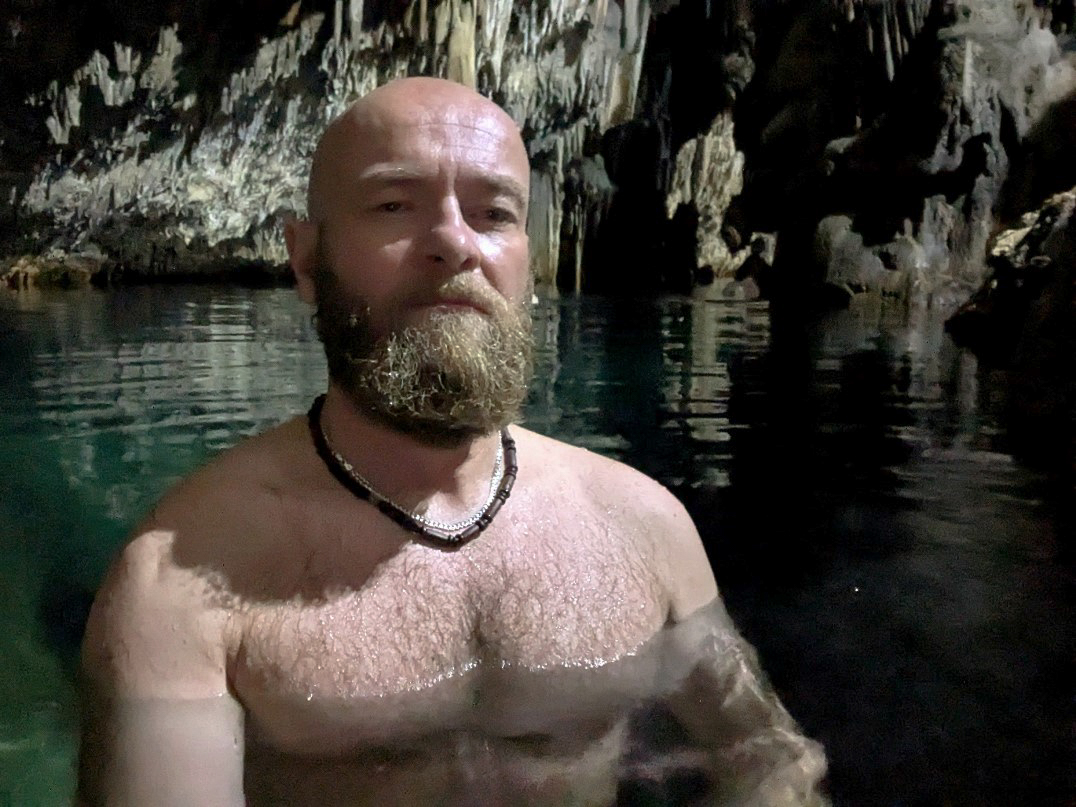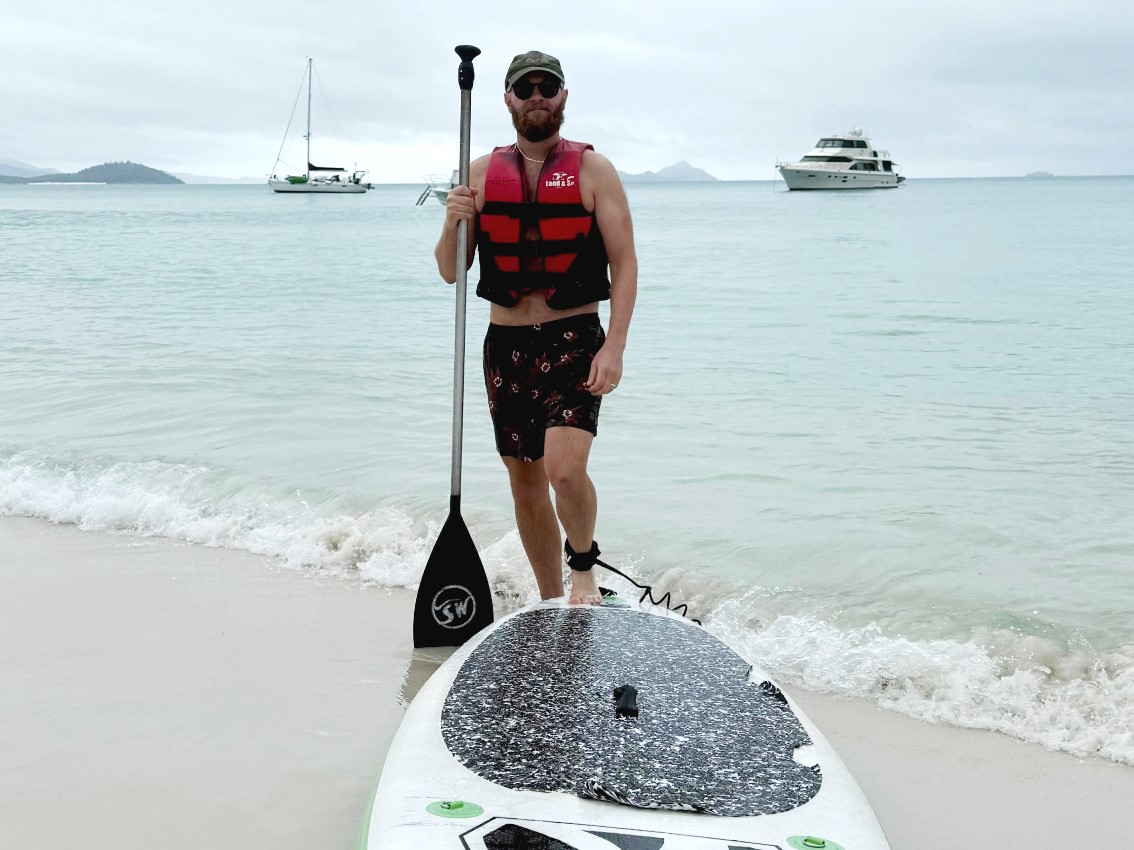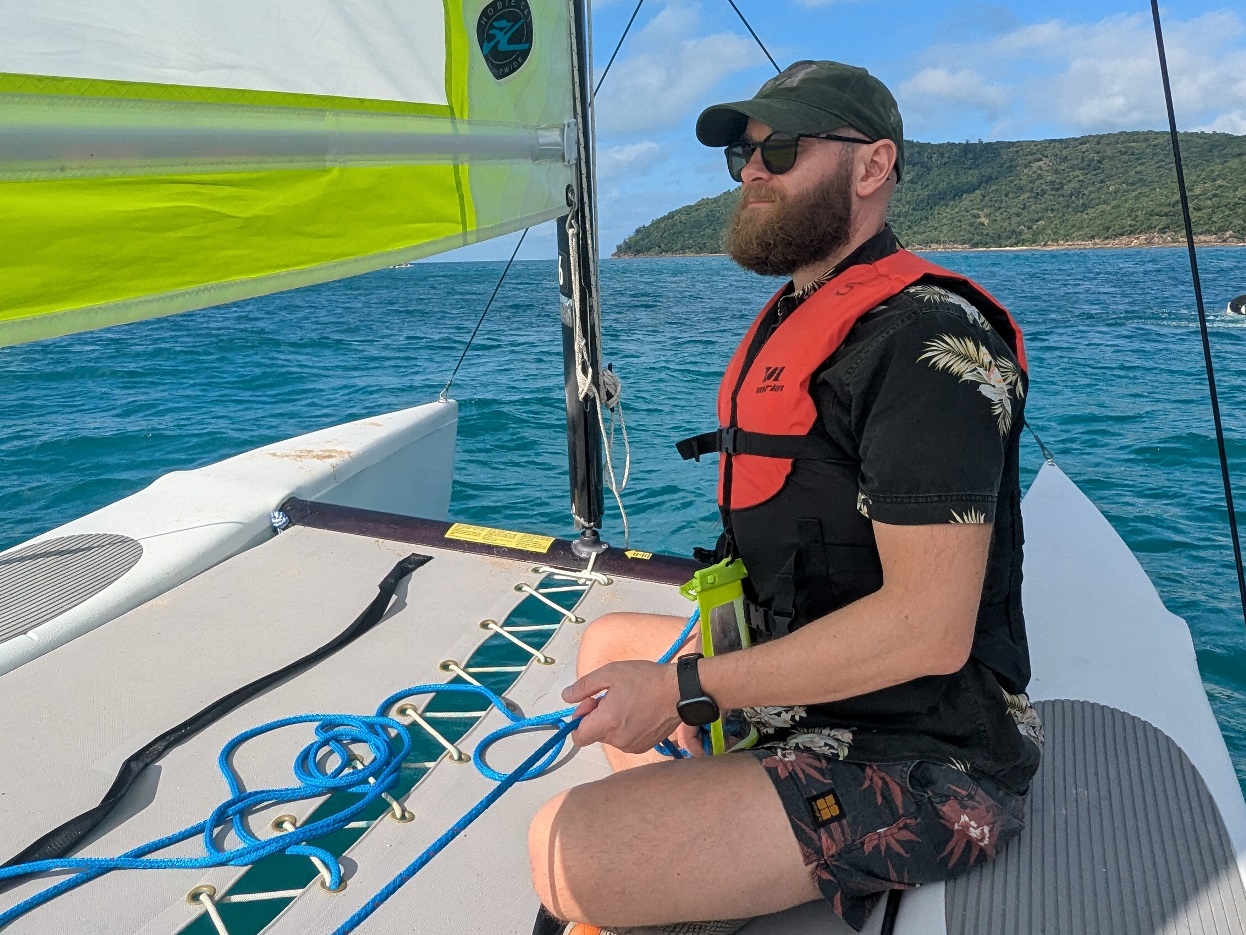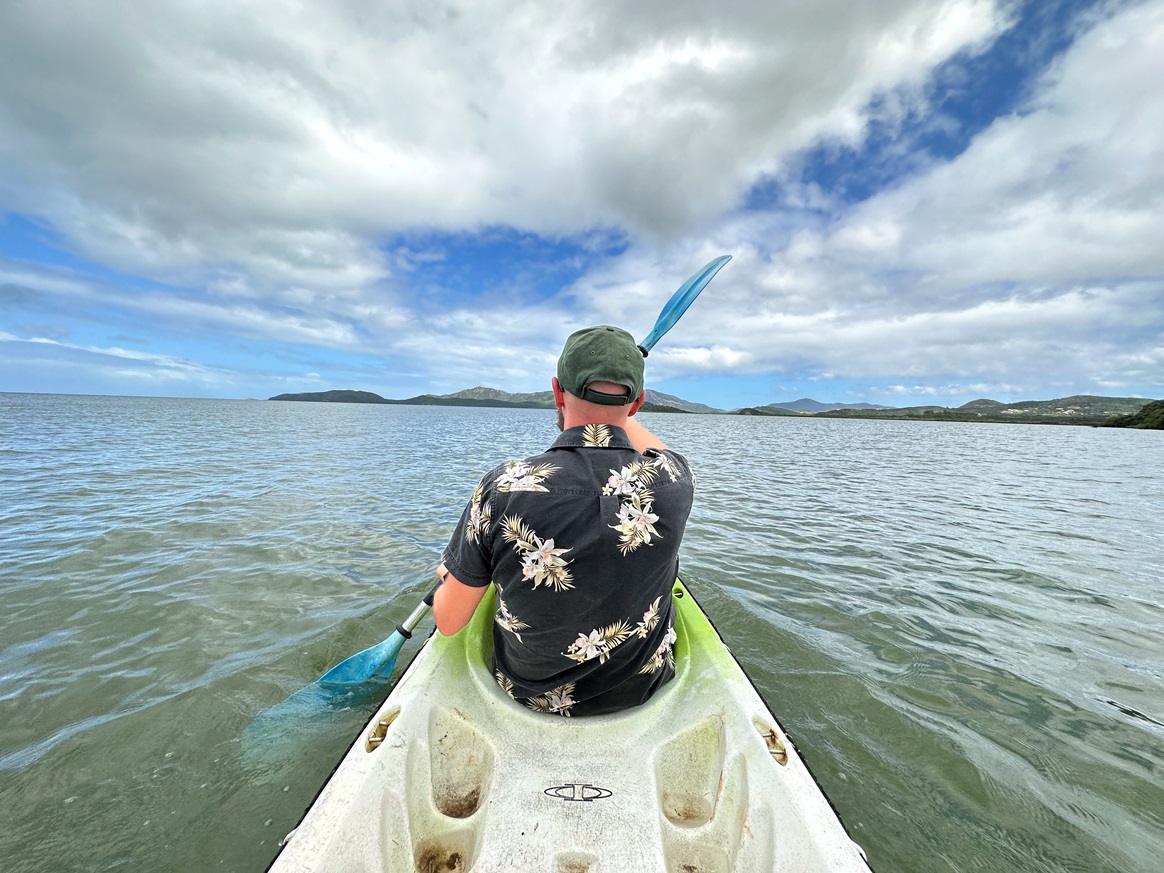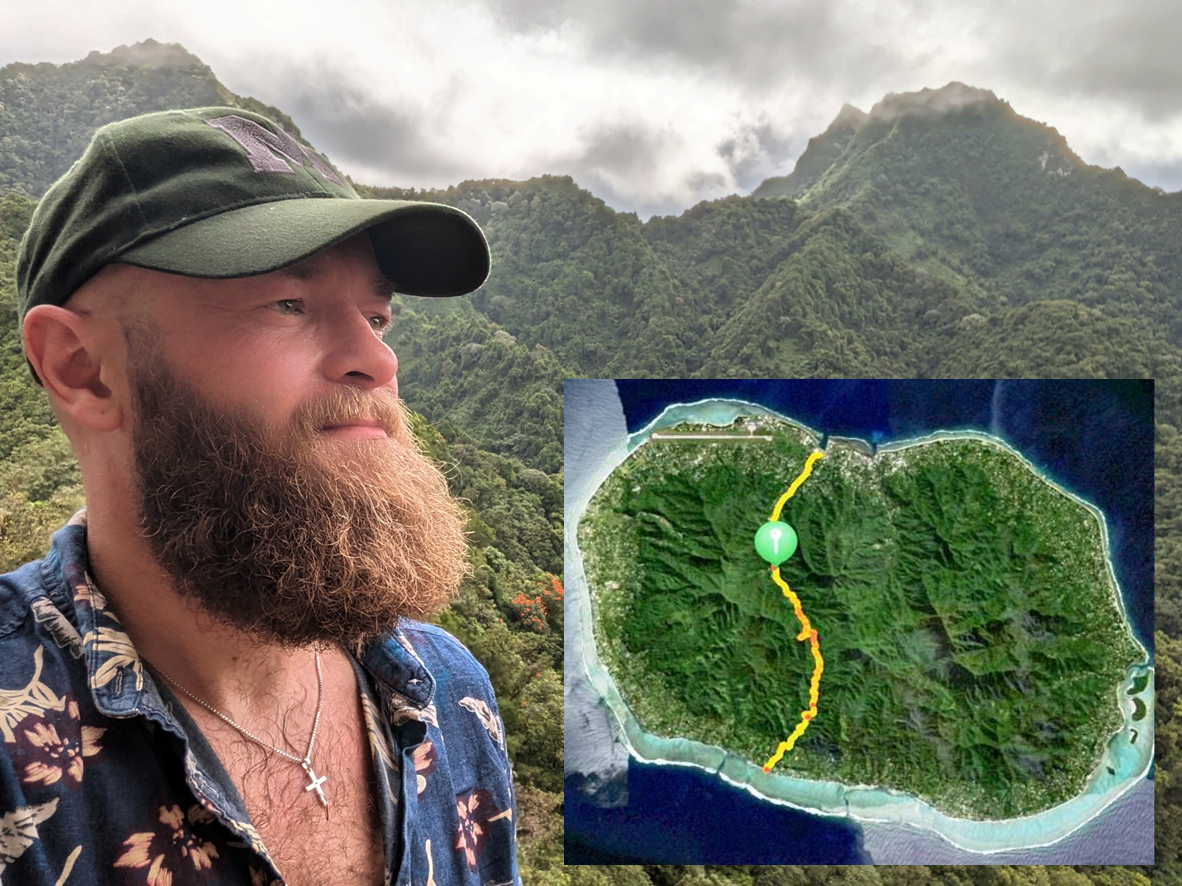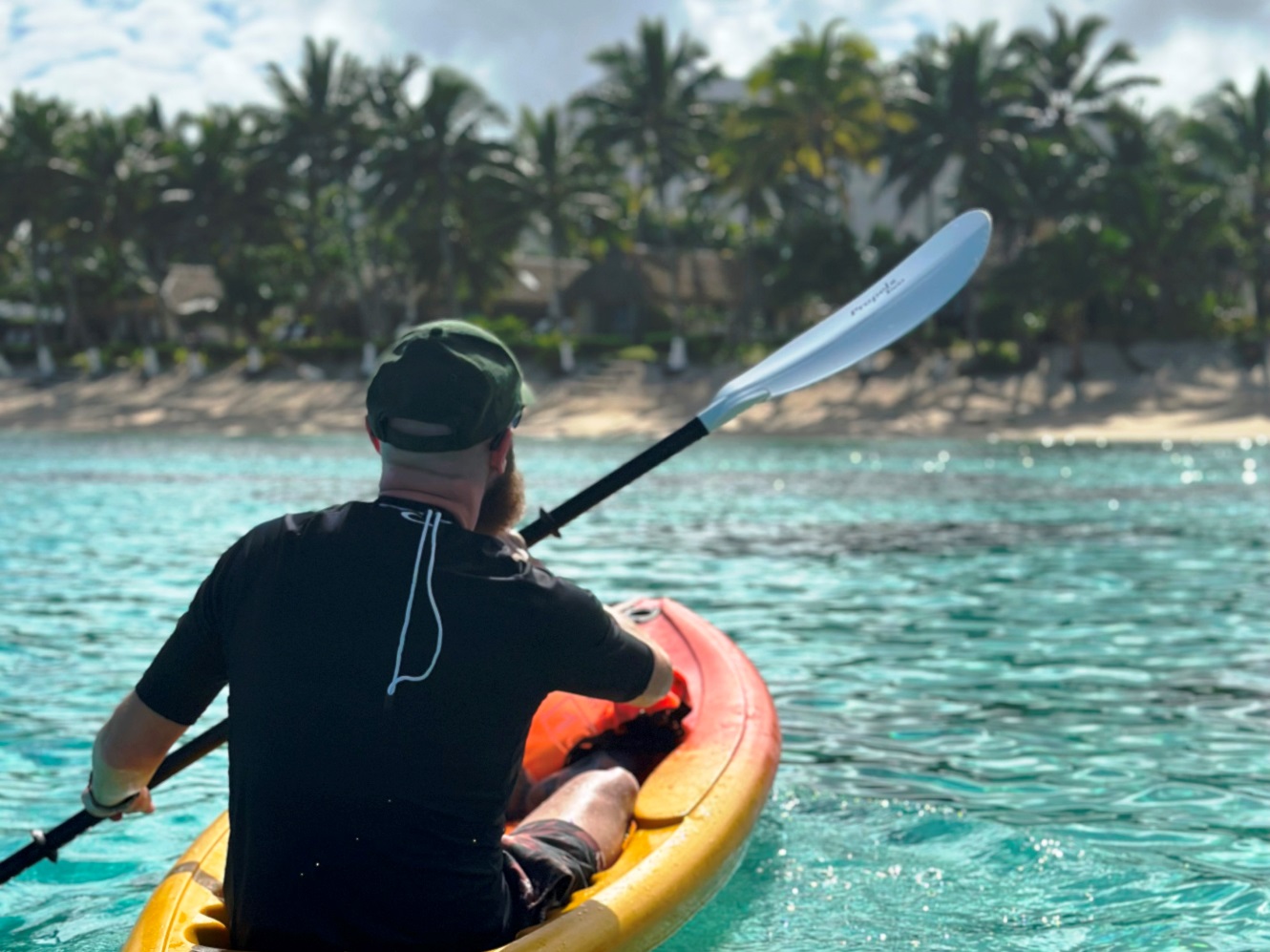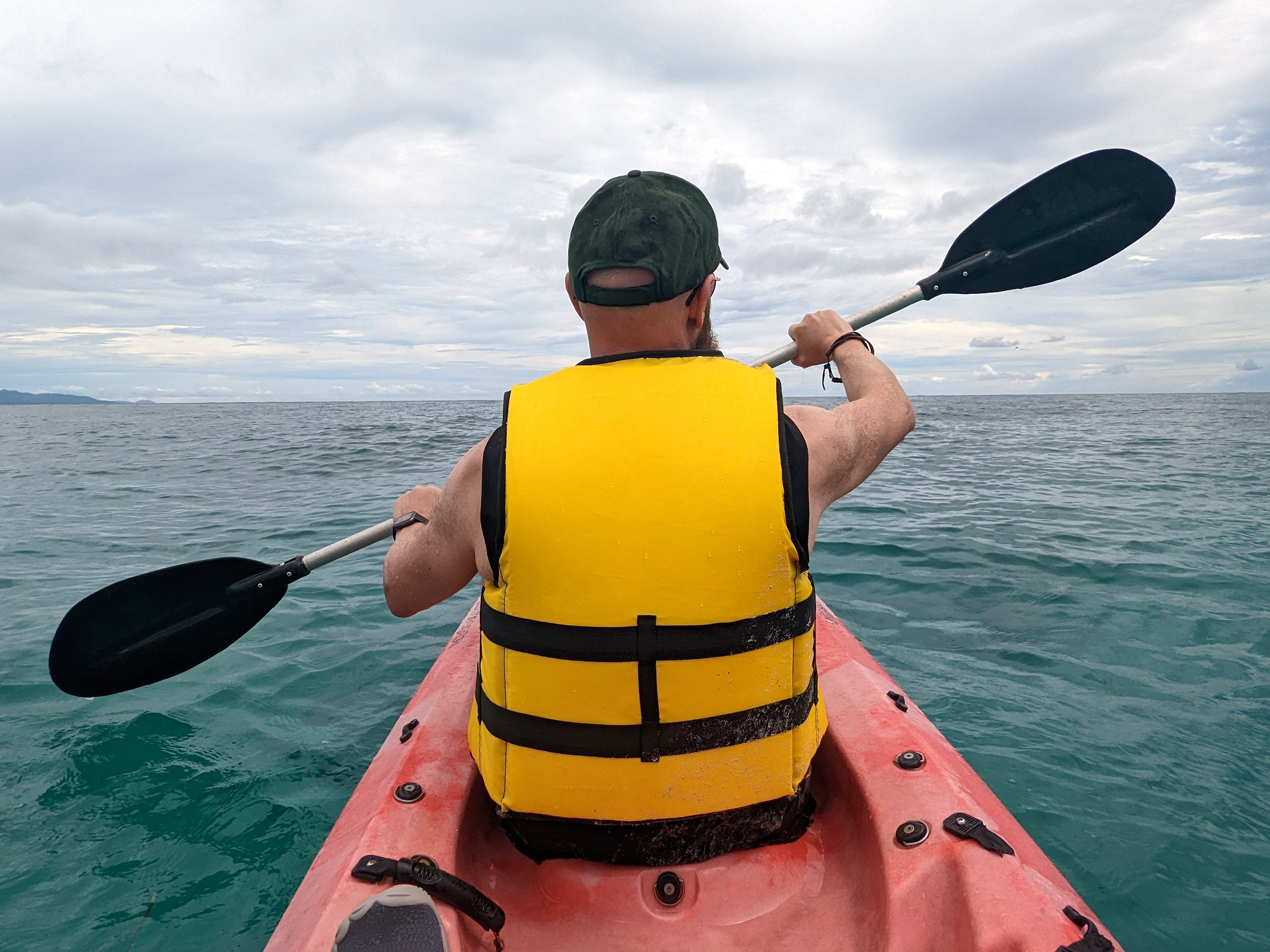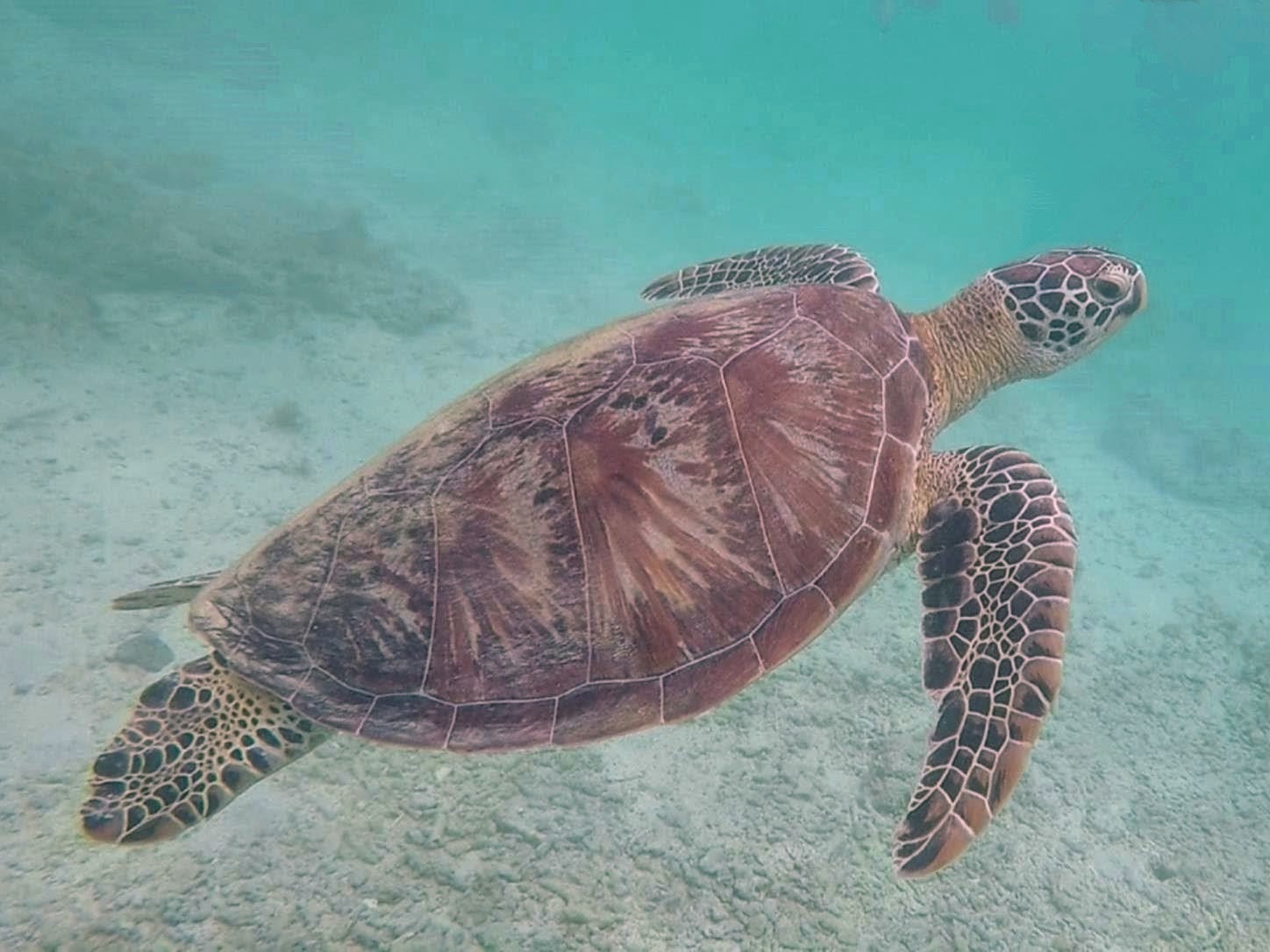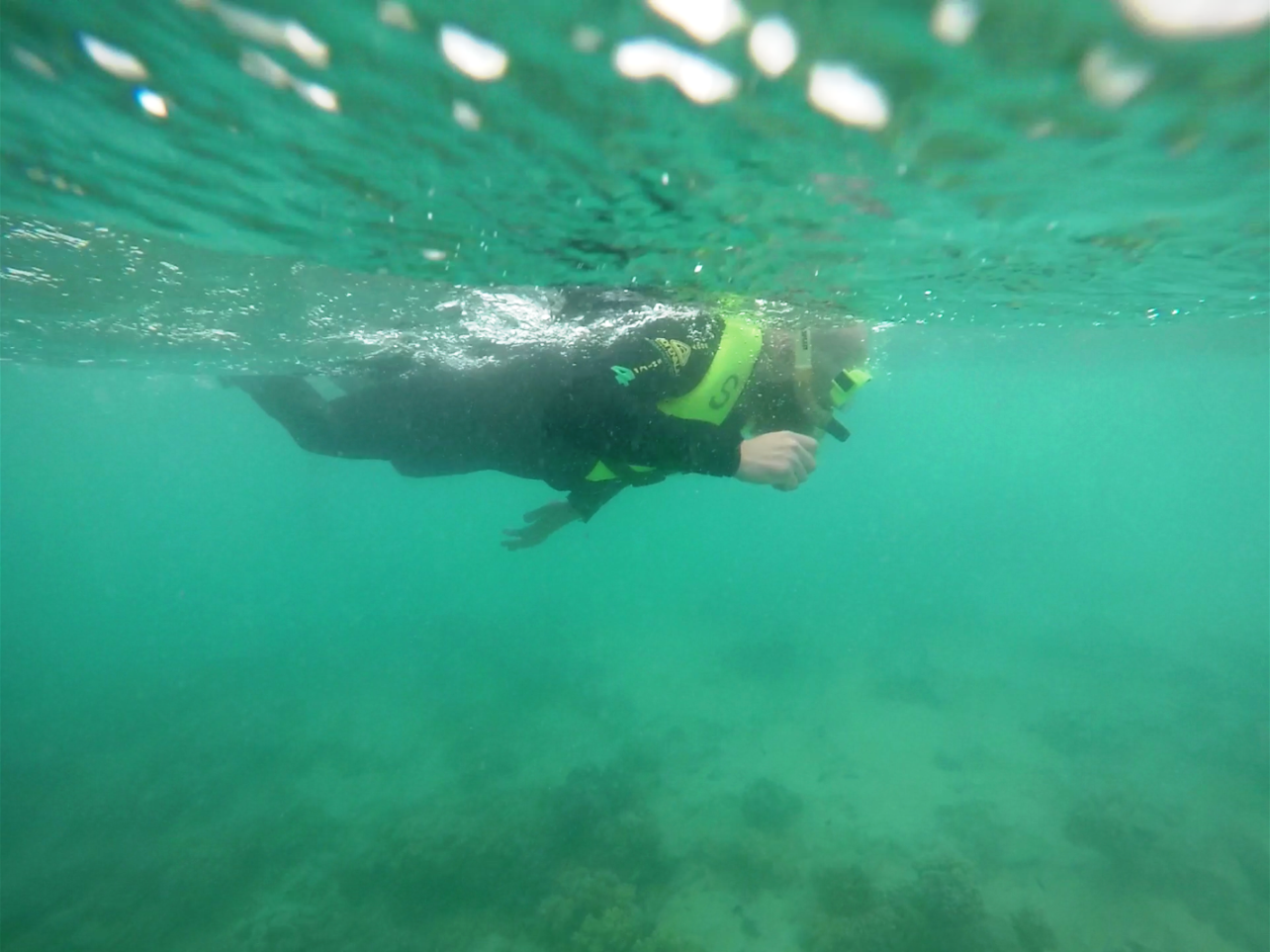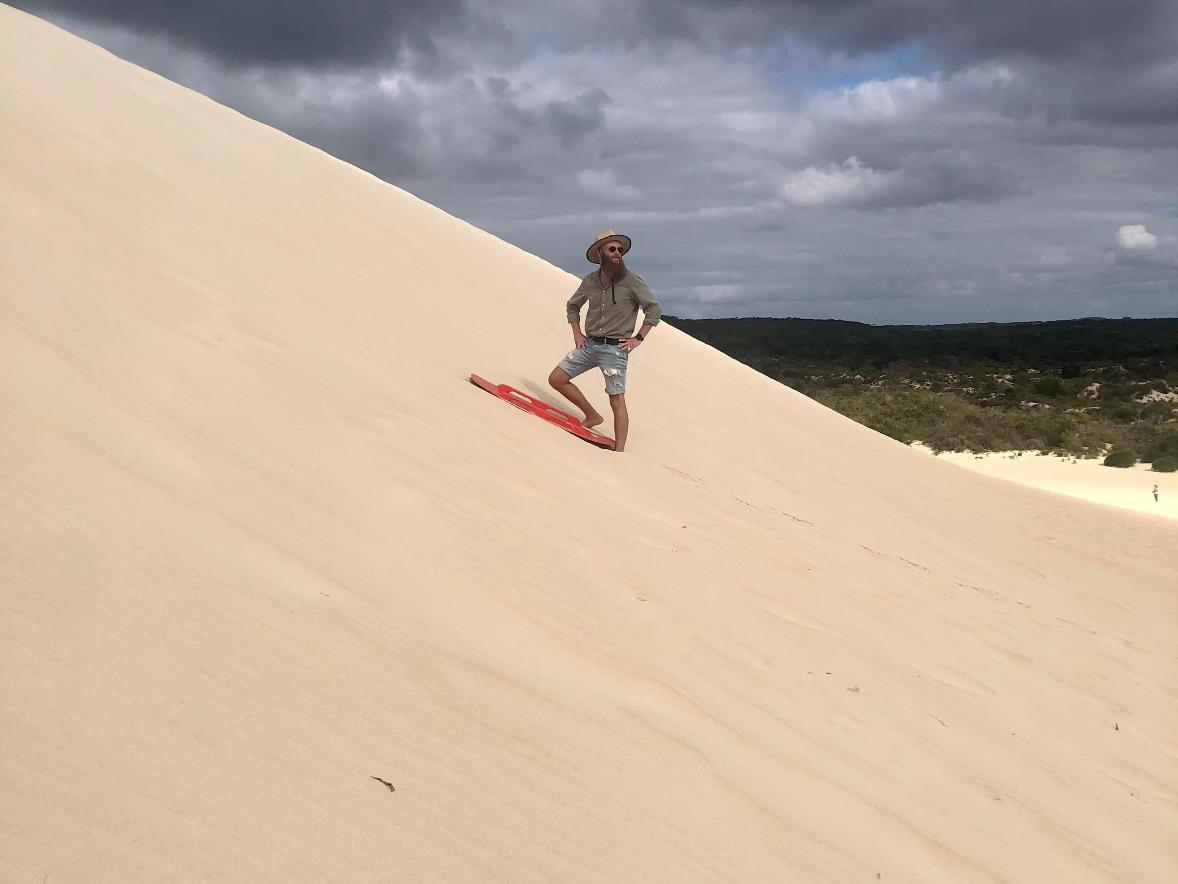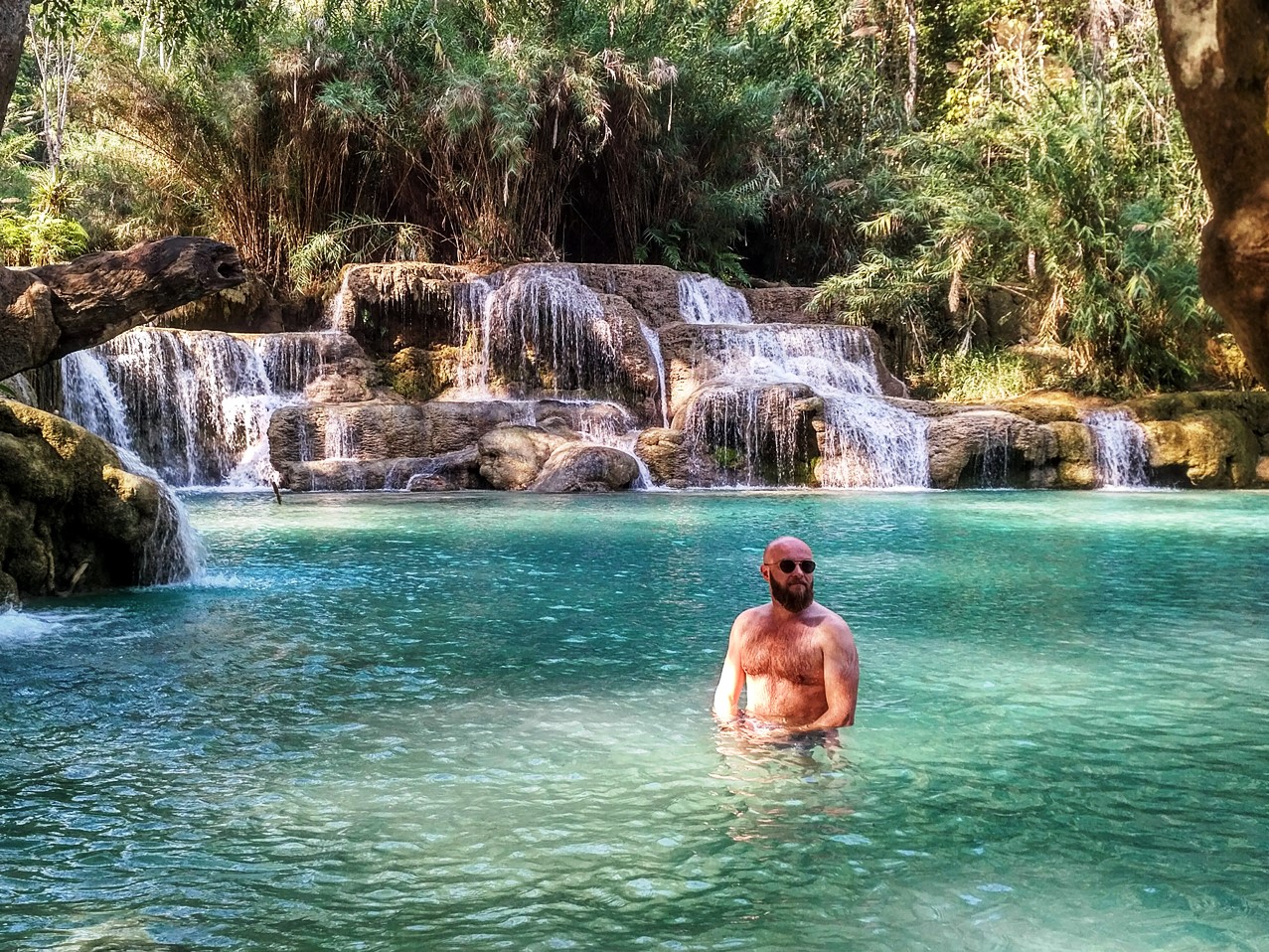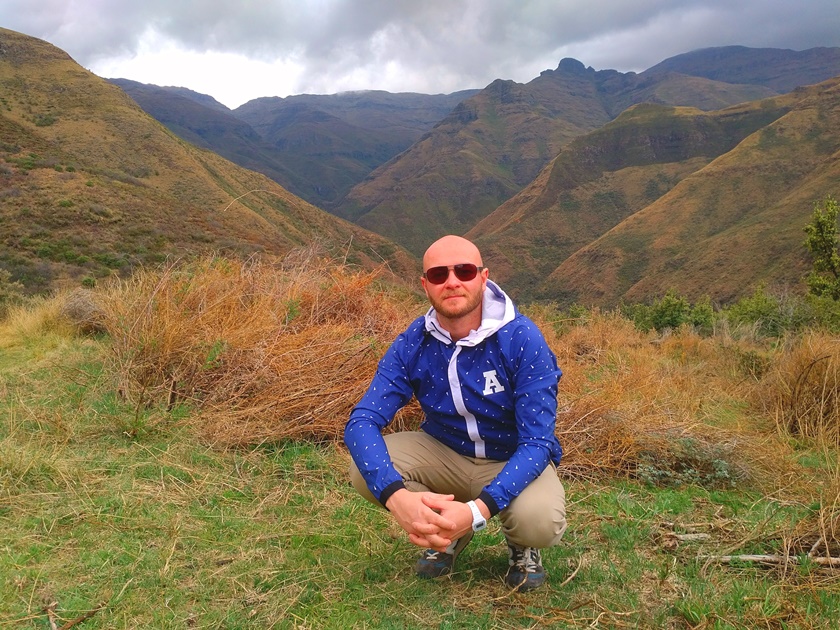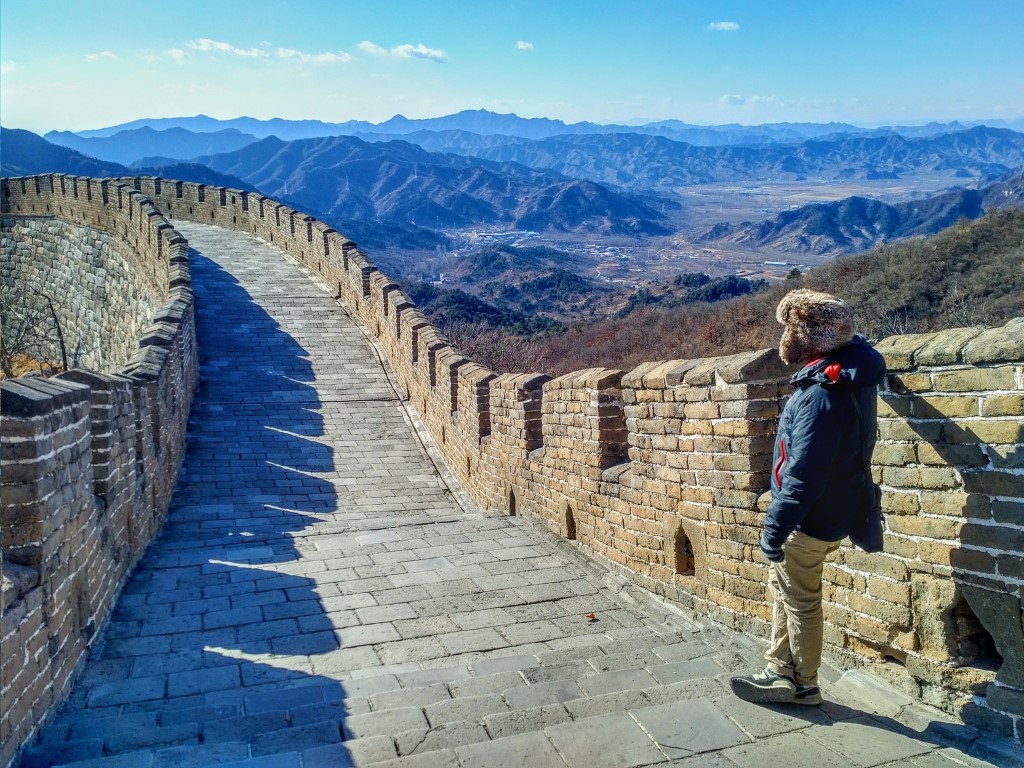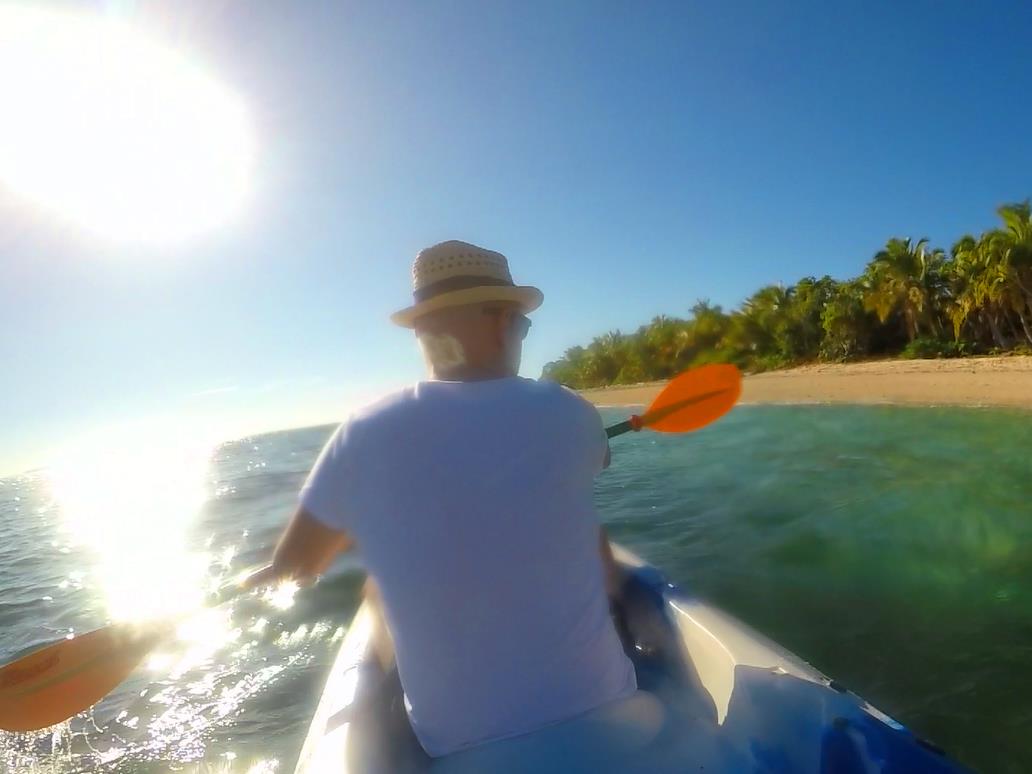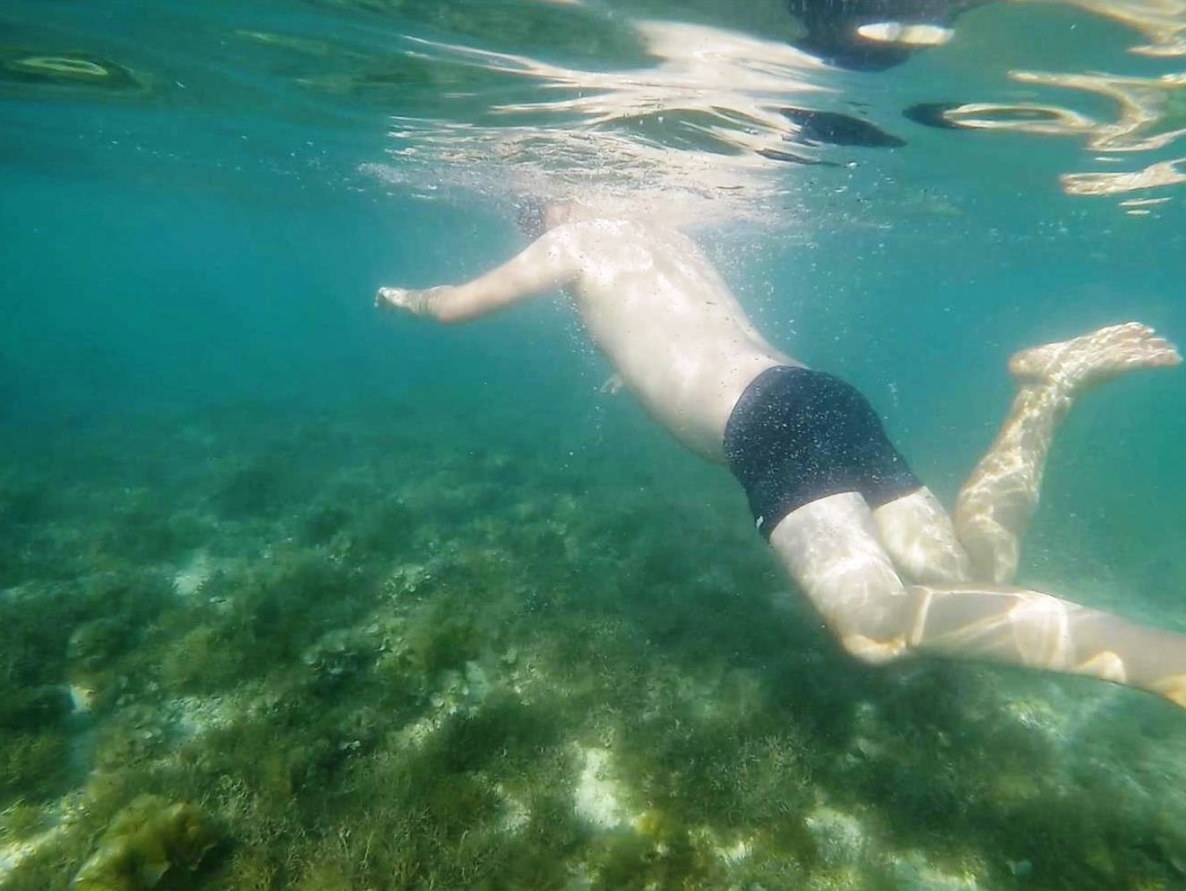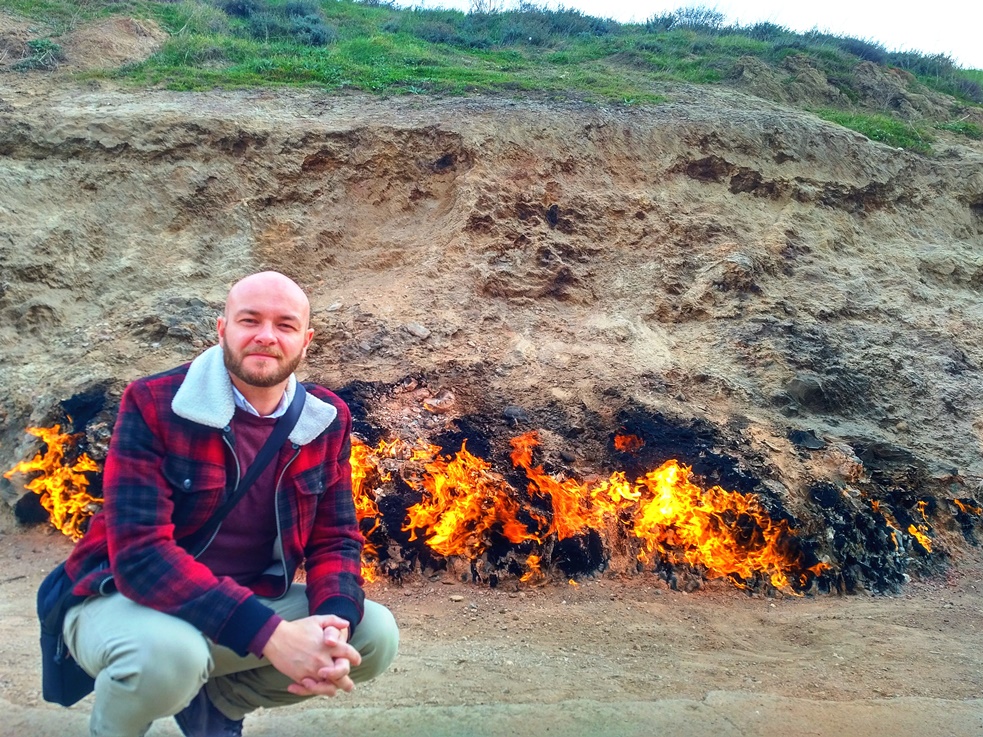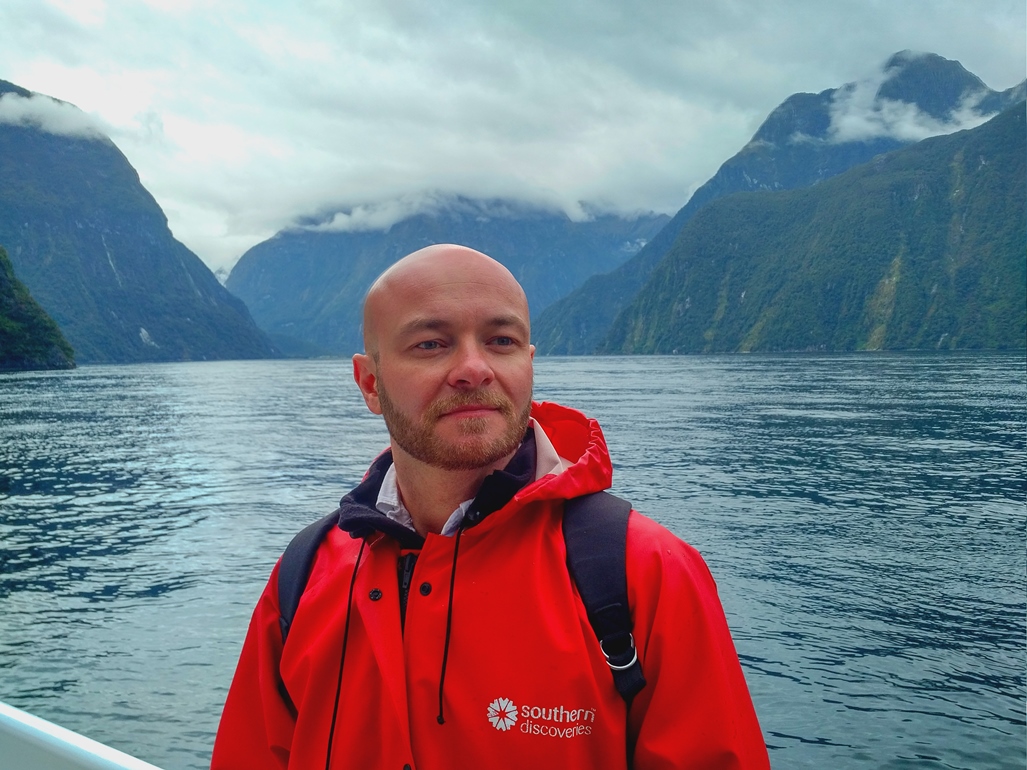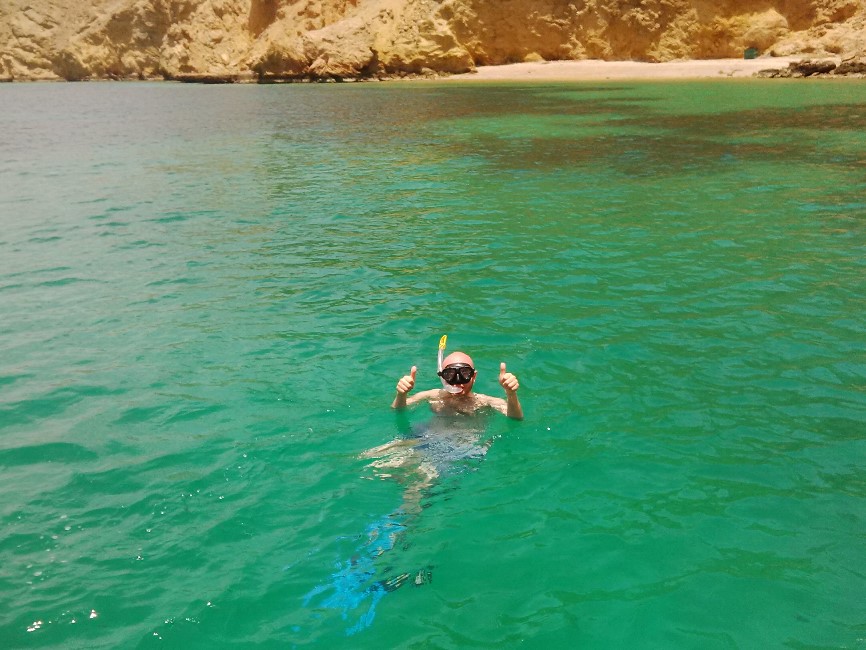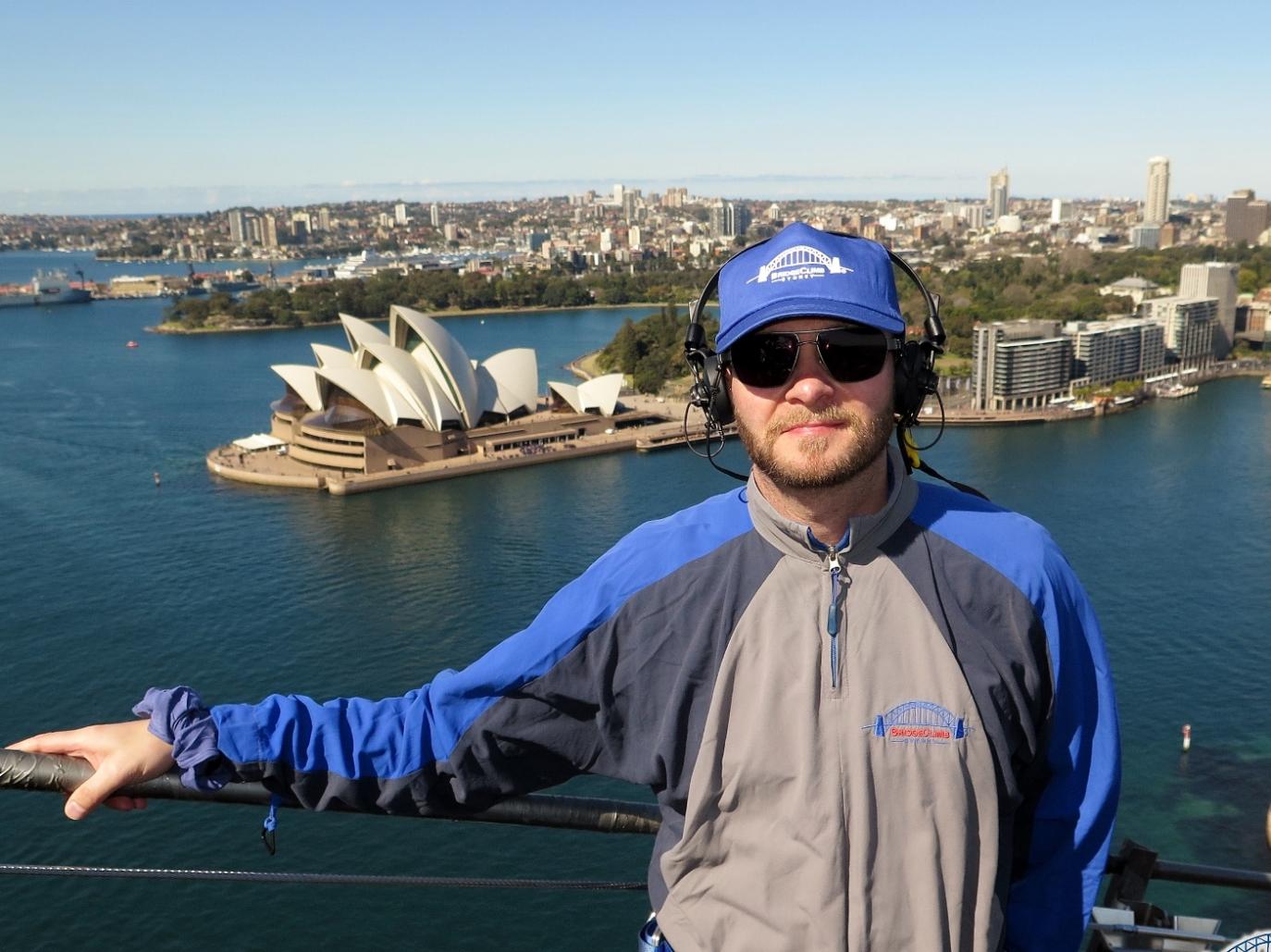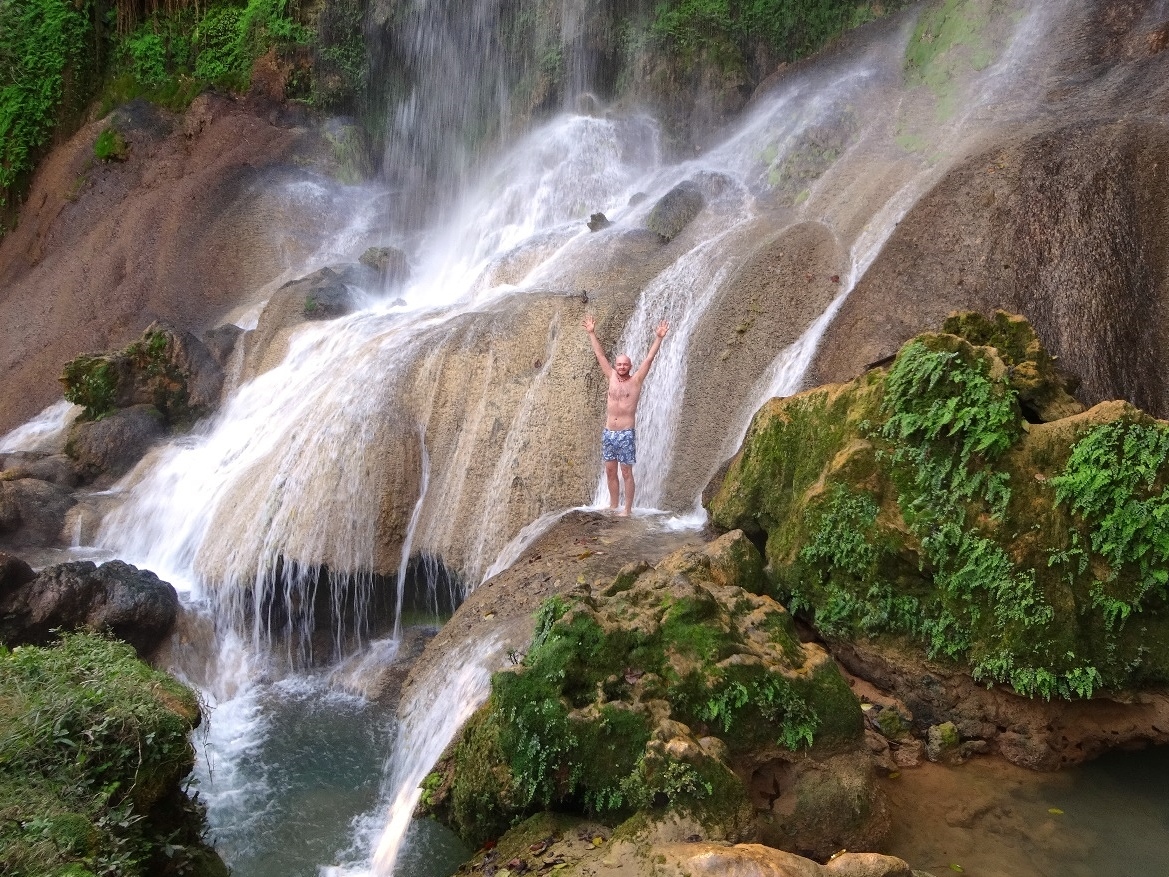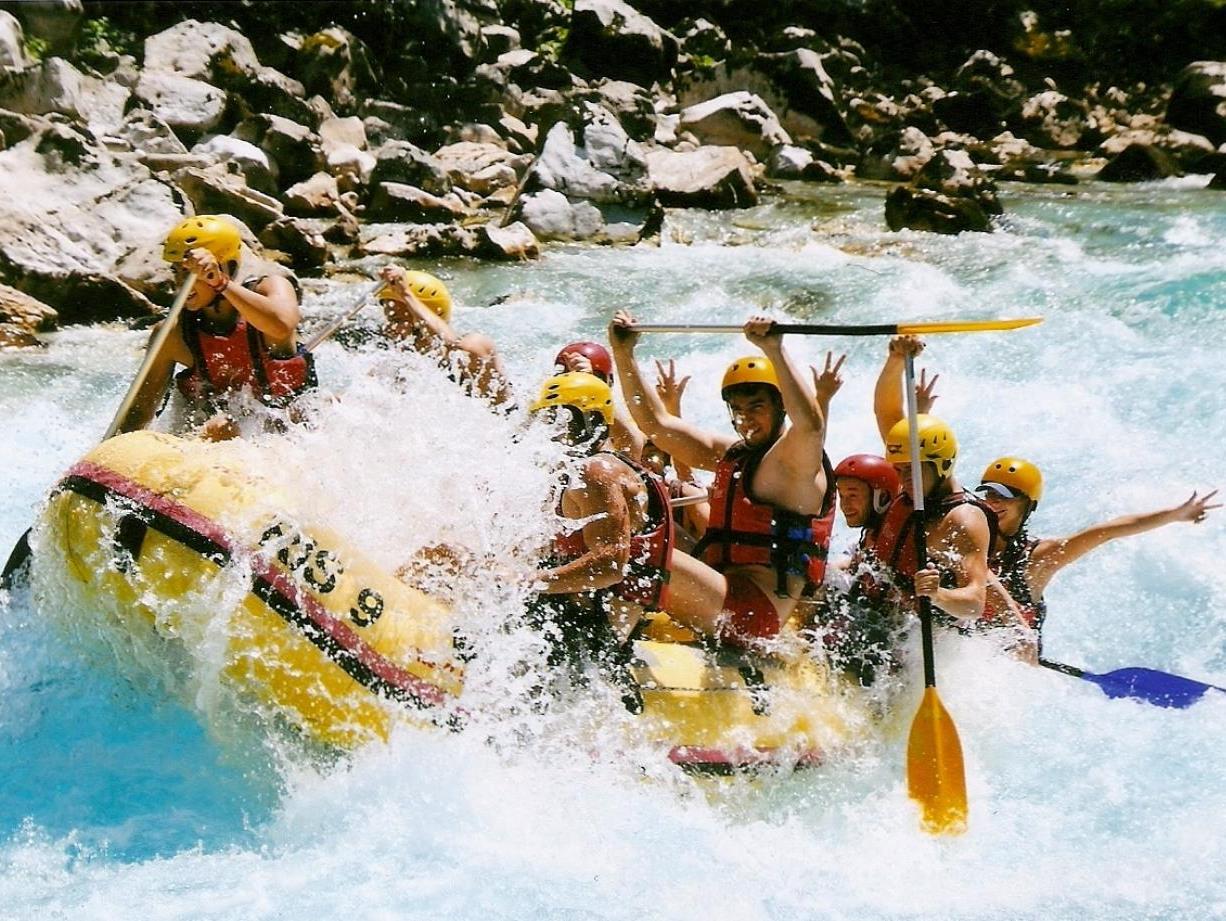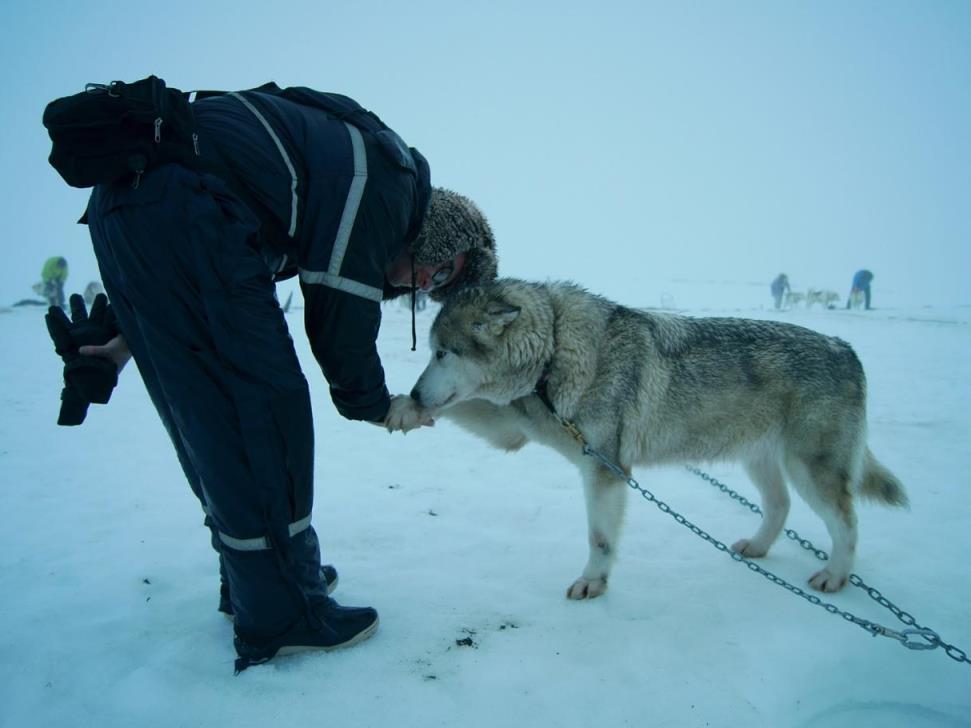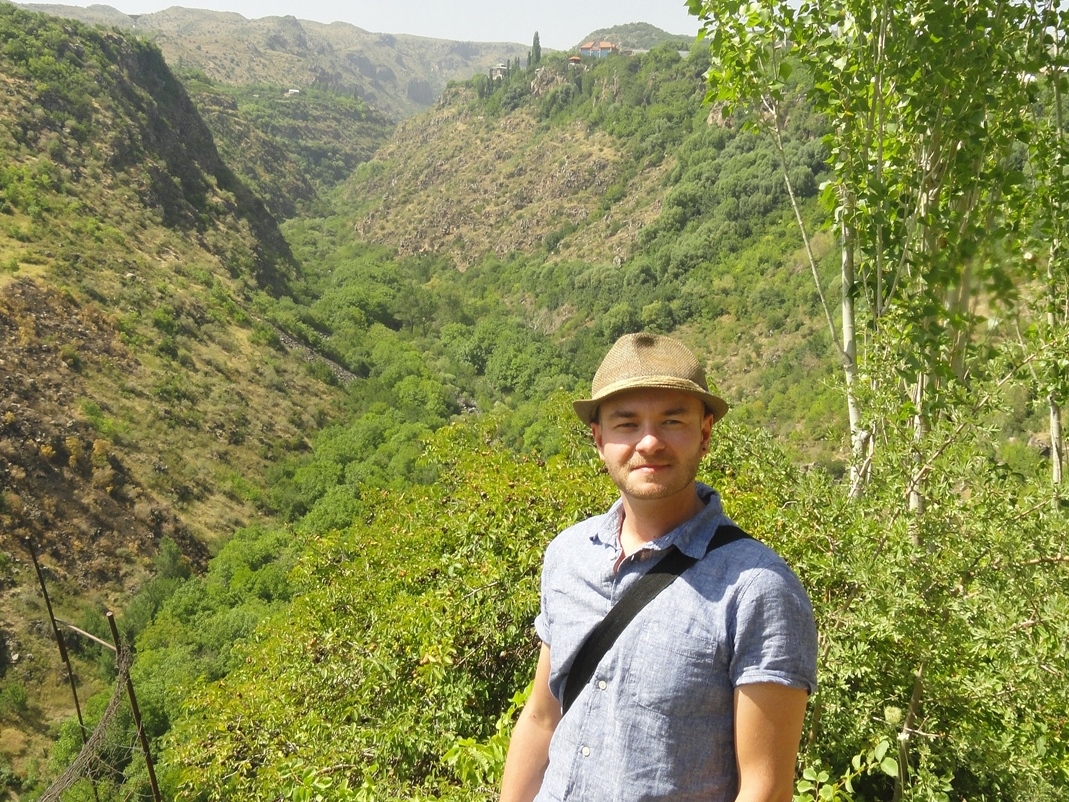
the adventure travel blog
From climbing a glacier in Iceland to hot air ballooning above Myanmar, from whitewater rafting through Bosnia-Herzegovina and into Montenegro to horse riding amid Lesotho's snow-capped mountains, and from walking along the Great Wall of China to snorkelling with giant Manta Rays in Indonesia, The Adventure Travel Blog compiles those incredible experiences in foreign lands which have well and truly taken me out of my comfort zone.
swimming in an underground cave pool in tonga
Haveluliku, Tongatapu, Tonga, July 2025
The Anahulu Cave was quite incredible and without doubt a fortuitous substitute for kayaking in the lagoon. I entered with my flashlight on my smart phone, gingerly ducking a low ceiling and entering along steps cut into the rock. Then! The cave suddenly opened out in front of me, a rocky chamber with stalagmites and stalagtites with a pool of darkened turquoise water. My kayaking gear (towel, swim shorts) were quickly repurposed for swimming in an underwater pool surrounded by nature's rocky chandeliers. It was otherworldly, incredible, beautiful. I switched clothes, donning my shorts in a brief moment of nakedness. I slipped into the water, water I'd assumed would be uncomfortably cold but was actually pleasantly tepid. I joined a small group of Australians in swimming in the pool, making my way around giant stalagtites to enter other chambers of the pool.
Click the photo above to head to my Travel Chronicle for this country.
sea kayaking in tropical north queensland
Hamilton Island, Queensland, Australia, June 2025
With the catamaran brought ashore, I headed back out into the waters of the Coral Sea in a bright orange kayak; I sure feel at home in a kayak these days, cutting through the water and churning through the waves and wobbles. A turtle came within a few metres of my kayak but, alas, I was literally the only person not to have seen it.
Click the photo above to head to my Travel Chronicle for this country.
stand-up paddle boarding in the whitsundays
Whitsunday Island, Queensland, Australia, June 2025
We donned lifejackets and headed out into the Coral Sea on stand up paddle boards (SUPs).
For the second time on this trip, this was a water sports first for me, which explains why I was so terrible at it, barely managing to stand up before plunging back into the water. Every time I fell, I laughed louder. I maintain that the paddle boards being the inflatable variety played a distinctly significant role in my failure to master this latest water sport, being, as they are, inherently more bouncy than the standard variety but, perhaps, I would have struggled anyway. Drenched, but happy, I dried off ashore, delighting in the natural textures and shapes of the beach as we headed back up to the northern end to collect our gear
Click the photo above to head to my Travel Chronicle for this country.
sailing a catamaran in australia's coral sea
Hamilton Island, Queensland, Australia, June 2025
Later that day I would embark upon my maiden voyage as co-captain of a catamaran...
Winds gusting above twenty knots meant that, when we arrived at the beach kiosk our hopes of sailing a catamaran were placed on agonising pause ("At the moment, it's a no", warned the guy at the counter). We sauntered off down the beach, killing time and considering our options until a final decision would be made. Luckily for us the call was made to go ahead, even though gusts of wind kept changing direction. We gathered around a catamaran docked on the beach for schooling in the art of sailing a catamaran by a twenty-something Aussie guy who'd seemingly stepped out of an episode of Home and Away, owing to his board shorts, blond hair and characteristically Aussie enthusiasm. The aforementioned gusts of wind stole every other sentence of his advice meaning that I headed onto a catamaran for the first time in my life with only a patchy understanding of how to operate the thing. One piece of advice I'd confined to short-term memory was the need to let go of the rope if the catamaran was toppling over. We set off and, for an hour or so, repeatedly changed sides to strike a balance between body and wind pushing against the mainsail in a bid to keep the catamaran vertical, adjusting the tautness of the sheeting to reduce or increase speed and pushing the catamaran's rudders left or right to control its direction. It was exhilarating trying to manage all of these elements to harness nature's forces and move the catamaran forward. Occasionally, everything would come together and we would magically cut through the water at a pace that was both exciting and somewhat frightening.
Click the photo above to head to my Travel Chronicle for this country.
kayaking in new caledonia's dumbea river
Dumbéa, New Caledonia, October 2023
It was only a short walk down from the hot tub to the beach, a brown sandy affair with characteristic overhanging palms, scattered coconuts and mangroves. The tranquil waters made a mid-morning kayak a relaxed undertaking - somewhat fortunate considering J'avais mal au dos. Underwater creatures splashed for cover as we passed slowly by - a slightly disconcerting reminder that we were not alone on these waters. I mused that they were probably just fish disturbed from their resting places among the roots of the mangrove trees but, inevitably, tales of New Caledonia's poisonous sea snakes were not far from my mind. A sultry hour out on the water saw the New Caledonian weather cycle through, seemingly, all four seasons in quick succession and on a loop: the sun would beat down, followed by the sweeping in of clouds, wind, rain sprinkles and then fierce sun again. This sedate but nonetheless enjoyable kayaking adventure was my only water-based experience in New Caledonia (that's if you exclude the hot tub).
Click the photo above to head to my Travel Chronicle for this country.
e-biking through new caledonia's wild south
Yaté, New Caledonia, October 2023
The Blue River Park in the Yaté region of Grande Terre's South Province was a 60 kilometre drive east of Dumbéa. Our helter-skelter drive up and down mountains was rewarded with vista comprised of a scorched red landscape home to unusual-looking vegetation. We drove to Pont Perignon where we deposited the car and hired two e-bikes for a princely sum. It was a half-day hire but we only had a couple of hours before we would have to begin the hazardous journey back up and down the mountain to Dumbéa; this wasn't a trip we savoured making in the falling light of dusk. Let loose on our e-bikes, we powered through 16 kilometres of the park's reserve, from Pont Perignon to the 1000-year-old tree at Grand Kaori. The journey was interspersed with multiple pit-stops to behold the truly otherworldly scenery along the Blue River. The dead white trees emerging from the icy blue of the river, known more poetically as The Drowned Forest, struck a remarkable sight against their mountainous backdrop. Indeed, amid the mists of passing showers (a bracing experience to bike through), the Blue River appeared almost spectral, almost ghostly.
Click the photo above to head to my Travel Chronicle for this country.
hiking across a polynesian island from north to south
Rarotonga, Cook Islands, July 2023
We set off in the morning, our backpacks stuffed with snacks, a battery pack and carrying as much water as any camel worth his humps would be proud of. This was a 10.2 kilometre hike, beginning in the island's north. Our destination? The island's south. The hike took us across fast-flowing streams with slippery boulders as stepping stones, up steep banks of mud with a web of tree roots acting as nature's ladder to what became a 327 metre ascent to a dark shard of rock known as The Needle. Chains bolted to the sides led up to the top of this intimidating edifice, alas a peak I would not be summiting. Even with the safety chains this sheer vertical beast was beyond my climbing capabilities and, indeed, my nerves. A small warning plaque at the foot of this monolith was enough to convince me to play it safe. Climbing The Needle is not part of the Cross-Island Hike anyway, but an added extra should you wish to be heroic or stupid enough to undertake the challenge. Although clouds draped themselves around the mountaintop like bed sheets billowing in slow motion, and the sky a pallet of differing greys, the views of the tree-covered valley were nevertheless a hiker's worthy reward. Unusual flowers, the like I have not seen before, occasionally but unashamedly graced the trail, as did a species of brightly-coloured butterfly called the Red Postman which seemed to appear and disappear as if trying to guide us through the forest. We were even joined by a couple of altitude-loving Roosters - one of which burst into a "cockle-doodle-do!" at an intersection along the trail. This wasn't the toughest hike up a mountain I've undertaken (that title has to go to Mount Sorrow in Queensland, Australia) but this wasn't the easiest either. Nevertheless, I'm pretty proud to be able to justly claim that I've hiked from one side of a Polynesian island to the other.
Click the photo above to head to my Travel Chronicle for this country.
kayaking in a pacific ocean lagoon
Rarotonga, Cook Islands, July 2023
Our villa was a few metres from a Pacific island beach which could have graced the cover of a glossy travel magazine: azure ocean waters speckled with dark coral patches beneath the surface, sprouting coconuts gathered in clusters underneath tilting palm trees leaning out to shore and blue starfish basking in the shallow waters like hand-sized navy jewels. A natural reef about a kilometre out to sea meant that the waters of the Titikaveka lagoon were gentle and shallow - ideal for spotting fish, sea cucumbers and starfish from on-board my kayak. We even sighted a turtle and something called an Eagle Ray. It was thanks to a couple of locals who were out snorkelling with their dog that we got to see these last two creatures of the Pacific. "Turtle! Turtle! Coming your way!" and "Eagle Ray! Eagle Ray - coming towards you" the woman took to shouting in her mangled vowels so characteristic of the Kiwi and Cook Islander accent. Admittedly we were above the water but it was cool to see their shadowy shapes pass speedily by our kayaks. "Did that dog follow you out?" I asked, assuming it was one of the many strays living on the beach. It was the elephant in the watery room I felt. "No, he's ours. He's an adventure dog", came the somewhat unexpected reply.
Click the photo above to head to my Travel Chronicle for this country.
hiking a mafia-controlled active volcano in the dark
Mount Batur, Bali, Indonesia, April 2023
Having cancelled our Mount Rinjani on Lombok trip, we opted for the Mount Batur sunrise hike - a volcano in northern Bali. This felt like the right compromise, especially as it would mean I'd still have hiked a volcanic mountain in Indonesia and so wouldn't be returning to Australia feeling empty-handed. Our hiking gear and snacks were going to be required after all! The hike meant a very early start, up at 2am and in the transfer car by 2:30am. By 3:30am we would be starting the hike in pitch darkness with only our head torches lighting the route. We went on our little sunrise adventure with two guides and three other hikers - a Scotsman and two Americans (via Poland and Germany). We arrived at the top of Mount Batur three hours later, having hiked pretty much non-stop through the blackness, slipping and sliding on the crumbly black earth, and gaining 500 metres in altitude. As we did so we would pass mafia men who were there to check that every hiker was accompanied by a guide; a criminal gang controls Mount Batur. Hike without a guide and you can expect trouble. We were assigned a place on a bench overlooking the volcanic crater, waiting expectantly for the sun to rise. Of course it did rise - albeit behind gathering clouds which seemed to thicken at every glance. Come on, Indonesia is in the Tropics so what did I expect?! Still, the views of the crater, lake and Mount Agung looming behind were some of the best views I've seen while out hiking. Our guide, Guday, approved of our hiking prowess ("I am very happy with you, very happy..." he took to saying cheerily on countless occasions). Earlier we had chosen to take the much harder but faster route up the mountain. As a result, Guday offered us the chance to extend our hike by a further three kilometres by walking along the volcanic rim rather than heading back down the mountain trail from whence we came. Everyone in the group agreed. It turned out to be the best part of the hike; the landscape became more dramatic as we passed geothermal steam vents on the mountainside, all the while scrabbling over sharp igneous rock and sometimes having little option but to ski down slopes of ashy sediment like it was black snow. It was along this stretch of the route that I spotted a couple of male Macaques. One was sat on a rock overlooking the crater eating a fruit. From behind I managed to capture what I think is likely my best photograph of the whole trip. The rest of the descent was fast and furious. I arrived back at the car with sore knees but a happy heart, the kind of heart swell that only comes from having pushed your personal boundaries and having stepped outside your comfort zone. Having awoken at two in the morning, a final satisfying denouement came when we arrived back at the hotel just past 10 o'clock - and just in time for a hotel breakfast which, we had assumed, we would miss. What an awesome day this was: mountain climbed with a fully cooked breakfast as reward. My heart was happy and my belly was full.
• Distance: 12.2km
• Elevation gain: 500m
• Total elevation: 1717masl
• 3:30am - 9:30am.
Click the photo above to head to my Travel Chronicle for this country.
snorkelling with giant manta rays in indonesia
Nusa Penida Island, Indonesia, April 2023
We set off again, the speedboat's engines churning up the cobalt blue and spraying us unceremoniously with petrol fumes. Suddenly we pulled over again at what felt like an impromptu place, likely, I thought, because our crew had received a tip about some Rays. There was a flurry of excitement on board. Snorkel masks donned. People dropped into the water. Only a few seconds passed until I saw my first Manta Ray, a giant flapping silver disk of a thing elegantly and calmly gliding through the water. I was naïve as to just how huge these things were. I was a little trepidatious for sure; this graceful bird of the ocean was significantly bigger than me. There were several more sightings in quick succession. I can be pretty certain they were not all the same animal because of a marked difference in appearance - the second being, as it was, noticeably darker and with glowing blue edges. Positively Sci-Fi. One of the creatures glided straight towards me, its fins undulating up and down, before veering, thankfully, to one side. It was really quite special. I'd spent almost an entire day travelling in the rain, on cramped boats in some of the worst tourist traps I have ever experienced as a traveller in order to spend what was probably less than two minutes' swimming with the Manta Rays. But what a wonderful two minutes it was...
Click the photo above to head to my Travel Chronicle for this country.
kayaking in the bohol sea in the philippines
Panglao, Philippines, October 2022
We based ourselves on the nearby Panglao Island at the Amarela resort, with its on private beach on the shores of the Bohol Sea. I was sure glad of its free availability of kayaks which meant that, on our first full day on the island, we were able to go sea kayaking, making our way along the coast, pulling up a nearby beach and enjoying the wild scenes. Indeed, so wild I was able to get my first ever selfie with a starfish, which was basking in a rock pool on the beach. I was more careful to avoid the black sputnik shapes of the sea urchins which seemed to gather together in small spiky clusters; stepping on one in Fiji, and having to pick the spines out of my feet with tweezers, wasn't an experience I wanted to repeat.
Click the photo above to head to my Travel Chronicle for this country.
swimming with turtles & sardines in the central philippines
Moalboal, Philippines, October 2022
The watery adventure started almost immediately. We climbed into the water (I was particularly glad of my rock shoes purchase from the mall the day before) and walked through the shallow waters leading to the boat. A carpet of strange looking seaweed was decorated with an incredible-looking species of starfish marked, as they were, with large black spots on an orangey-coloured body. We clambered up the ladder of the boat and were soon zooming towards Pescador Island. We spent around an hour snorkelling over a piece of coral reef, swimming down as close as we could to capture video on the GoPro. Swimming with sardines was next, an experience known as 'The Sardine Run'. Huge mesmerising schools of sardines twisted and curved, their silvery bodies sparkling as they caught the sunlight above the water. One school was particularly enamoured of a piece of large coral closer to the surface, posing the perfect chance to get closer to this underwater spectacle. I never expected to see any turtles; as a traveller of many years and edging ever closer to 100 countries, I've grown cynical about travel hyperbole in blogs and on social media where everything is perfect and oh-so-awesome. I've learnt not to get my hopes up. I'd seen starfish, been snorkelling and swum with sardines. I was happy with that. But the turtles eclipsed everything: these placid, gentle things with beautiful big eyes were completely
unperturbed by my presence. They are, possibly, the most beautiful creatures on the planet. Swimming with turtles was never on my bucket list but it should have been. A day trip to Moalboal, which was only half-organised the day before, and which also involved a brush with scammers, was an incredible one which went a long way to justifying the entire trip to the Philippines.
Click the photo above to head to my Travel Chronicle for this country.

skiing in the australian alps
New South Wales, Australia, September 2022
This was a week-long skiing trip to the white slopes of the Snowy Mountains at Thredbo, sleeping overnight in Jindabyne. As I clamped on my skis, I entered a whole new world of stocks, goggles, snow ploughs and chair lifts. It's fair to say that I was a little apprehensive, it being nearly thirty years since I last donned a pair of skis in France back in 1992. My experience was, practically speaking therefore, zero. Nevertheless, I set about doing my best but, as I know too well, I am horrific at following verbal instructions. I made progress and was soon skiing down Thredbo's Friday Flats slope. Sometimes, even, I managed to make it to the bottom of the slope without stacking it. Lazier moments saw me take to the chair lift to Australia's highest lifted point on Mount Kosciuszsko, where I sat in the snow, cracked open my Thermos flask and took in snowy views of Australia's highest mountain ranges with aa steaming coffee.
climbing a mountain in the world's oldest rainforest
Queensland, Australia, April 2022
Mount Sorrow, 680 metres tall, sits deep inside Daintree National Park. Research online yielded cautionary tales which very nearly dissuaded us from undertaking the 12 kilometre Ridge Trail. It was steep with a required elevation gain of 633 metres, would involve pulling oneself up the mountain using ropes and was infested with leeches. This last fact very nearly put us off entirely but the chance to climb a mountain in the oldest surviving tropical rainforest in the world was one I just couldn't resist. We had to give it a try. As it was, we set off with some degree of trepidation; trepidation heightened by the fact that we hadn't really anticipated going on such an expedition when we set off from Sydney. As a result we didn't have everything we needed: we were short on water bottles and only one of us had hiking pants. Psychologically we were also a little under-prepared having decided only that morning to commit to the trek. We squeezed through a small gap in the rainforest wall marked only by an insignificant-looking wooden sign marked "Mt Sorrow Ridge Trail". Within seconds we were in deep green forest, light levels had dropped because of the density of palms at the rainforest canopy and we were already on a steep ascent. There was little time to acclimatise or adjust; the challenge started immediately. This was going to be a tough one but, I solaced, I had climbed many an Aussie mountain and had hiked myself through a respectable chunk of Aussie bushland. I therefore felt that I had it in me to complete what would become, although I didn't know it at the time, my most challenging hike in Australia to date. The trail seemed interminable, whenever we thought we must be nearing the top, another stretch of steep climb unfurled in front of us. We looked out for the climbing ropes which, from online research, we were told to expect and, sure enough, there they were. They appeared at one of the steepest sections of trail. It wasn't long before I was on the ropes clambering up the muddy trail but, not before the looseness of the rope had me swinging unexpectedly left and crashing into the ground. Ego and legs bruised.
After an eternity of steep ascents, with only a few insignificantly short flat stretches, we reached the top. Our hopes of seeing the view from the summit were dashed; the clouds so characteristic of Tropical Australia during the official Wet Season had swallowed everything. No matter, just hiking here was reward enough for me. It was at the summit where we foolishly let our guard down. What I hoped would be a little respite and a chance to take stock before commencing the descent turned into a battle with leeches. They took to swarming onto our bags which had been placed on the metal platform and began scrambling up onto my boots. Before I knew it, the stringy beasts were making their way up my trousers - and fast. It was then that I spotted one on my hand. All the furious shaking in the world would not dislodge. The speedy deployment of an Australian Medicare card, seemingly appropriate, enabled me to scrape it off. I set about scraping off others on my boots and on my clothes. It was at this point that, true to its namesake, the rainforest experienced a deluge of rain. Barely rested from the hike to the summit, we set off back down the ridge having been chased off it by the leeches. The rain had now made the descent additionally treacherous, with large muddy stretches and slippery rocks and roots now characterising the hitherto dry trail. I slipped multiple times and, at one point, bruised my hip.
It was half-way down Mount Sorrow that I began to feel a strange itchy sensation on my ankle. I had dismissed it at first, considering it to be something related to the rubbing of my hike boots but, after a while, I decided to investigate. Pulling back my socks I saw a squelch of blood and one fat leech gorging itself on my skin. I have to admit I freaked. The Medicare card was once again deployed, as was antibacterial wound wash, wipes and band aids. Beleaguered, tired and fast running out of water, I was thankful we only had a few more kilometres left. The remainder of the descent was made more memorable by the sighting of a black slug and some particularly incredible specimens of trees which could have been straight out of a fantasy film. The misty drizzle of the rain added to the otherworldly, mystical nature of the forest which I took delight in beholding on several occasions - even though I was mindful of our dwindling energy, water and the prevalence of leeches. We also had no option but to walk under the largest spider I had ever seen suspended, as it was, above the trail in its orb. Clearly we had not seen this on the ascent earlier. I thanked my lucky stars that I had not walked head-first into the thing. I have never been so happy to get to the hire car in my life. Looking back, it was clear that Mount Sorrow threw everything she had at us: the rains, the perpetual ascent, the leeches. I couldn't help but muse at how apt the name of the mountain was. The clue was in the name, of course: Mount Sorrow. But I wouldn't have had it any other way.
Click the photo above to head to my Travel Chronicle for this country.
snorkelling in the great barrier reef
Queensland, Australia, April 2022
The journey from Cairns to our first snorkel spot Upolu Reef took well over an hour and was as bumpy as any boat ride I've been on; lurching and tilting and skidding. Not always having been the best on boats I made sure I stayed outside in the fresh air and focused on the horizon way off into the distance. Indeed, on this kind of travel experience the journey is also part of the destination, as demonstrated by the happy little Green Turtle we spotted bobbing in the turquoises of the Coral Sea.
Admittedly, it had been quite some time since I last went snorkelling. I'm no novice having had the pleasure in Vanuatu, Fiji and Oman. However, on jumping into the sea with my snorkel gear attached, I immediately drew the attention of one of the crew who came to rescue me with a life buoy: embarrassing in retrospect but I was glad of his assistance at the time. It seems that the cold of the water (even with my anti-Stinger wetsuit on), plus the need to breathe through my mouth rather than my nose, was a little too much for me to co-ordinate on first entering the water. Still, it wasn't long before I was happily snorkelling over coral filming the fish in their underwater world as I went. A second snorkel in the afternoon at an alternative spot, Upolu Cay Reef, offered an enhanced view of the watery world; water levels had dropped and winds, which had stirred up the sea bed earlier on in the day, had eased. This was where I was able to behold this watery place in all its colourful otherworldly majesty. This most famous of travel experiences was marred only slightly by a leaky snorkel mask which kept letting salt water up my nose and into my eyes. The mild irritation I felt at the failure of my snorkel equipment evaporated in the knowledge that I was enjoying one of the 7 Wonders of the Natural World and one of the most famous experiences in world travel. I arrived back in Cairns at dusk, my body exhausted but my heart filled with a sense of achievement.
Click the photo above to head to my Travel Chronicle for this country.
climbing cradle mountain on christmas day
Tasmania, Australia, December 2021
We were up at six in the morning and out of the hotel by seven, hurtling south-westward from Devonport to the Cradle Mountain Visitor Centre along Tasmania's deserted roads. From research conducted previously I knew this would be my hardest climb up a mountain to date; I was bracing myself for a challenge and don't mind admitting that I was filled with trepidation. In the early morning dusk glimpses of Cradle Mountain from our moving car showed purple-coloured peaks topped by ominous clouds. Pathetic fallacy indeed. The unreliability of mountain weather forecasts meant that, even at this late stage, there was still no guarantee that this would be the day we would be able to make the ascent; mountains are notorious for having their own weather systems. On arrival at the National Park Visitor Centre we were greeted by cold and feisty winds which immediately had me wishing I had packed warmer clothing. A member of Tasmania Parks staff warned, with typical crude Aussie candour, that it was "colder than a dead grandmother's kiss up there", and checked with us that we had everything we needed for our climb. She also warned us that there had been "two or three" helicopter airlifts from the mountain in the last couple of weeks because of bust ankles and broken bones caused by slipping on rocks. With coach tickets handed over and a final verbal exchange, we headed over to the shuttle bus which would take us the 10 kilometres from the Visitor Centre to the start of the hike at Dove Lake. Signing in at a portacabin (Aussies call these "demountables") as an extra precaution, and donning my spare pair of trousers over my shorts such was the biting cold, it was about 08:30 when we commenced the 14 kilometre hike. This was the perfect time to begin; there were very few others around and we had the evocative site of the Dove Lake boat shed foregrounding a monochromatic and misty Cradle Mountain pretty much to ourselves. On our return leg, and in the bright sunshine of a blue sky afternoon, the boat shed would be teeming with chattering tourists, kids and selfie-sticks. I thanked my lucky stars that, many hours previous, we had enjoyed this place without them.
As we followed the shoreline of Dove Lake, I took to anxiously looking up at the peak which was shrouded in a constantly shifting mist. Picking up a sweaty pace but in the chill of the fresh mountain air meant I was reduced to oscillating between putting on and taking off clothing as my body temperature fluctuated. Within an hour, my spare pair of trousers were finally returned to the bottom of my backpack. The route took us through a magical little wooded area called the Ballroom Forest, an otherworldly woodland draped in green algae, moss and lichen before things took a distinctly more vertical turn including scaling the rough cliff edges by gripping onto the chain rails. The higher we climbed, the bluer the skies became. Looking back across where we had come afforded incredible views of Dove Lake and Crater Lake and their surrounding slopes. Much of the hike did little to challenge me; the route was not unlike many of the hikes I have completed in the recent past. It was not until we reached the boulder-strewn slope on the final leg to the summit that things became interesting. Clambering over the (thankfully dry) boulders, some the size of small cars, was not the problem; it was only when I reached a point where I could no longer clamber over them but had to vertically climb up them that I decided to finish my climb there. I had made it higher than most and was within about thirty metres from the summit. But, I figured, I had had an awesome time and didn't fancy being airlifted to a hospital on Christmas Day. How embarrassing would that be? Ending up as the lead story on the local Channel 7 News was not exactly the look I was going for... A top tip when climbing a mountain: know thy limits. Indeed, my hiking partner had stopped a couple of hundred metres below me and had refused to budge; I had pressed ahead up until this point on my own. This was achievement enough in my mind. Later on that evening, in the banality of our Devonport hotel, I took to plotting the position I had reached on a photograph of the mountain I had taken that day. I was more than impressed with myself that I, a mere city-dweller, had reached this height (red marks the spot). As is always the case, descending the mountain was more painful than ascending, my knees in particular suffering the most. My confident and nimble ascent up the mountain now contrasting strongly with my clumsy descent characterised by frequent complaining, stumbling and falling. Mindful of not wanting to miss the final coach back from Dove Lake, our food stop also had to be brief. A bread roll, humus and can of kombucha was our Christmas dinner on the mountain before we recommenced the descent. The physical pain I felt was made somewhat more bearable by unsurpassed views of the Cradle Mountain chain now set against clear blue skies; from a distance I managed to capture Little Horn, Wiendorfer's Peak and Barn Bluff in a single photograph.
Click the photo above to head to my Travel Chronicle for this country.
sandboarding giant dunes on kangaroo island
South Australia, Australia, April 2021
Sandboarding and tobogganing down giant sand dunes is not something I'd traditionally go for; I have an aversion to anything which feels like a Disneyland-style experience. However, I figured that I'd get to see some impressive dunes as part of the deal and so signed myself up. I was right: the dunes were impressive - especially when, after a torturous clamber up it, I sat astride the ridge where both slopes met. The journey down was fast - so much so that I zoomed straight into the bushes at the bottom of the dune. I had sand in my ears, beard, nose and my pants. It got everywhere. Sadly, it also got into my trusty digital camera which was in my pocket. Its lens filled with sand and had jammed. You live and learn, I suppose. A little saddened by the loss of my old travel buddy, I took a saunter along the pure white sands of Hanson Bay Beach at Karatta.
Click the photo above to head to my Travel Chronicle for this country.
summit hike to rawnsley bluff in the flinders ranges
South Australia, Australia, April 2021
We stayed for two nights at Rawnsley Park Station with its awesome views of the Flinders Ranges and convenient access to the Rawnsley Bluff hiking trail. We determined to rise early the next morning to complete the hike before the mercury rose too high and, by 07:50, were starting our trek, pausing briefly to enjoy the sight of a couple of Western Grey Kangaroos somewhat silhouetted in the distance against the horizon. The hike's difficulty level is described as "Challenging" with "steep terrain" and thus braced myself for a bit of a slog - or "a doozie", as an Aussie would say. Within minutes my face was running with rivulets of sweat taking most of my sun protection with it. We eased into the ascent, navigating the ants' nests along the way. These were the same ants I had came across in Upper Colo a couple of months earlier. Standing on a nest for less than a second brings scores of them out in defence, swarming over your trainers, into your socks and up your legs. Having experienced these before I knew exactly what to do when they now took to attacking my feet: scream loudly and hit my ankles with rocks, my baseball cap and anything else I could lay my hands on. These nests are difficult to avoid in places; they're often located on the trails themselves meaning you have little option but to tread on them; I did so, but only on the understanding that any longer than a footstep would bring the beasts out of their nests and on the offensive. The silver lining to all of this was that the ever-present threat ensured a fast-paced hike, completing both the ascents and descent way ahead of our expectations. The sandy shingle beloved by the ants soon gave way to a vertical, boulder-strewn affair. Indeed, much of our 500 metre ascent took place on this kind of terrain. I remember thinking this must be where the adjective "challenging" is earned. Having reached the top of the Bluff, we extended the hike by a further 2 kilometres to enjoy the view of the Ranges from Wilpena Lookout. All in all, we'd covered 12.5 kilometres with an elevation gain of 520 metres in a little over four hours - and this included multiple stops to take photos. It was close to mid-day when we arrived back at the car; I was swiftly overcome with a wave of tiredness which had me retire to bed for a fair chunk of the afternoon, rousing myself around early evening to set off on a scenic off road drive along Bunyeroo Gorge. I'm glad we did because there was an incredible view of the mountain road snaking out to the Flinders Ranges which were, by that point in the evening, growing purple in the fading light. The vista seemed fitting capturing, as it did, the very spirit of road tripping like no other I have seen before.
Click the photo above to head to my Travel Chronicle for this country.
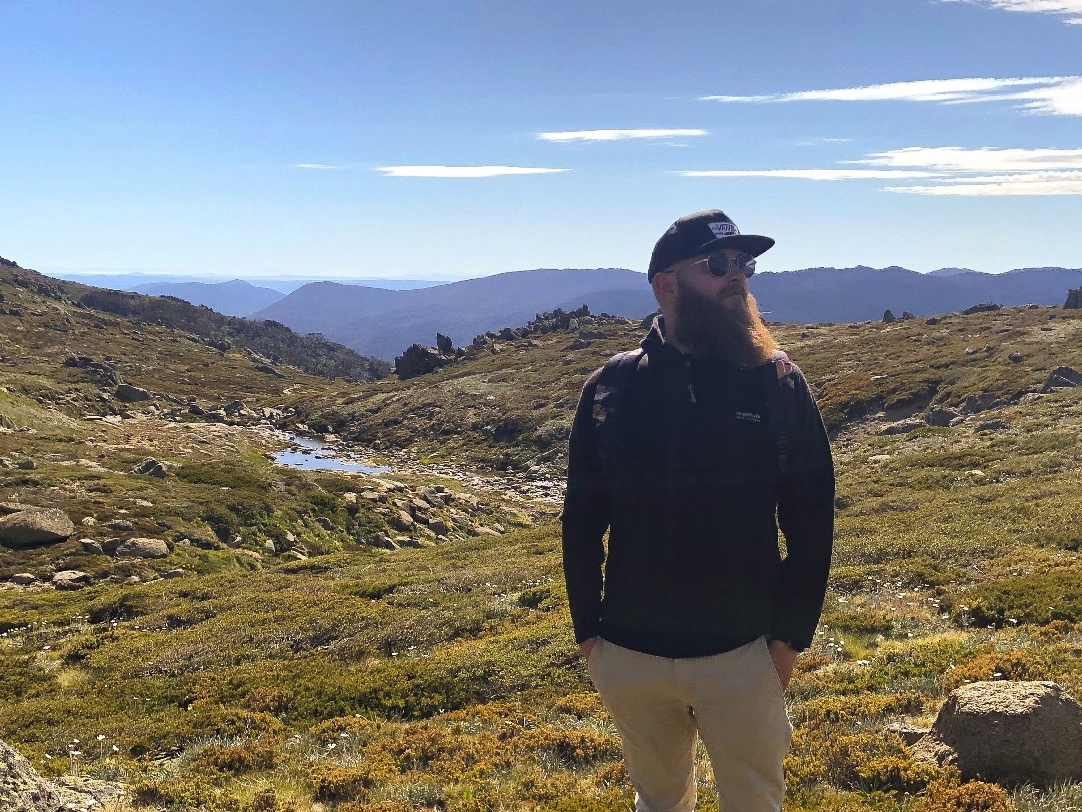
summiting australia's highest mountain
Mount Kosciuszko, Australia, December 2020
This has been on my Aussie bucket list for a couple of years now and, with the Queensland border closure scuppering a planned road trip from Brisbane to Cairns, the opportunity to climb Australia's highest mountain finally presented itself. I was initially hoping to make it to the summit of ‘Mount Koz’ on New Year’s Day; this seemed like the most poetically satisyfing option. However, where hiking at (relatively) high altitude is concerned, practicality had to take precedence and so we took to sifting through ten days of weather reports so that we were summit-bound on the best weather day. There's nothing worse than getting to the top of a mountain and being unable to see a thing.
This being such a poor year for travelling anywhere, we also decided to max out on accommodation costs by booking a chalet for two nights at Crackenback, near Jindabyne. It was an investment which was to pay off in unforeseen ways. Not only did the booking allow us to avoid the very worst experiences guaranteed by staying in yet another run-down Aussie motel but it also meant that at dawn and dusk we would find ourselves sharing the grounds with a mob of kangaroos. I must say that sipping freshly brewed coffee outside in the morning whilst watching a mother and her joey enjoying the landscape as much as I, was, in itself, worth the exorbitant price tag.
Looking out to the mountainsides from the chalet I quickly got a sense of the changeability of the weather in this part of New South Wales; quick downpours, blackening clouds followed by bright blue skies. We stuffed our backpacks accordingly not knowing what to expect en-route to the top of Australia’s tallest mountain; windproof macs and layers and gloves. Much of it was surplus to requirements in the end; hiking ever upwards at a fast pace inevitably meant we were shedding layers rather than adding them. Still, better safe than sorry.
We set off from the chalet at around eight in the morning to be sure we’d get to Thredbo with enough time to find a parking spot and be there for when the chairlift opened. As I stepped out of the car I could feel a distinct fresh Alpine nip in the air which had me thankful we’d been cautious in our preparations. With formalities complete we were soon on the chairlift and being cranked upwards to the start of our 13km hike. There were plenty of others undertaking the same endeavour but, on such a vast mountain, we soon fanned out, resulting in a tranquil morning spent in the bright sunshine passing exquisite Alpine flowers and hearing the faint bubblings of the famed Snowy River of ‘The Man from…’ renown. There was time to admire Lake Cootapatamba - Australia's highest lake – as well as use the facilities of Australia’s highest public convenience.
This is the highest and longest hike I have ever undertaken when compared to my previous efforts on Wales' Mount Snowdon (1085m) and Lesotho's Drakensberg-Maloti mountain range (2080m). I have also survived an altitude sickness-inducing overnight stay in a yurt on a mountaintop in Kyrgyzstan at 3012 metres but this didn’t involve any hike to the top. And so, reaching the summit of Mount Koz, two thousand plus metres above Australia, felt like a real achievement. For a second or two I must’ve been the highest person in the country. Unsurprisingly my descent was a little less fast-paced and less dignified, my manly struts up the mountain replaced by hobbling and tripping down it. I didn’t care; in my tiredness there was a sense of earned satisfaction that I had hiked to the top of Australia’s highest mountain.
swimming under a waterfall in northern laos
Luang Prabang, Laos, January 2020
Our first morning in Luang Prabang was undeniably a highlight of our entire three week journey - a trip out to the awesome Luang Si waterfalls. We set off later than we'd have liked, keen, as we were, to get there before the rest of the town's tourist population did. Our driver, Chantay, made good speed; it was satisfying to zoom past the public buses (basically tuk tuks with benches facing inwards down both sides) with people crammed in them. We were all going to the same place - but we would get there first. Sometimes travel is unfortunately all about timing; it creates a pressure cooker effect where being late or having a lie-in means you're likely to have to share the highlight of your holiday with a whole bunch of people who seem pre-programmed to spoil it. Thus, we heeded the advice of online reviews and got there earlier than most. This meant that we were able to swim in the turquoise pool of the incredible falls - possibly the best I've seen travelling - with only a few reticent people of the 'I'm not getting wet' ilk gazing on rather than being in there with us. This resulted in my capturing some awesome photographs and a carefree swim in relative peace and quiet, aside from the little fishies which took to nibbling at my legs and feet. We set off further up the hill to the source of the cascades, meandering up slippery slopes and the steps which the waterfall had, in parts, reclaimed for herself. Water flowed over my beat up trainers but I didn't mind - it was nice not to be traipsing around hot concrete streets looking at temples for a change. On our descent an hour later it was clear that the hordes had arrived; families spilled out over picnic tables, the turquoise pools were now home to a dozen or more swimmers and there were queues at the best posing spots. We made quick our escape.
Click the photo above to head to my Travel Chronicle for this country.
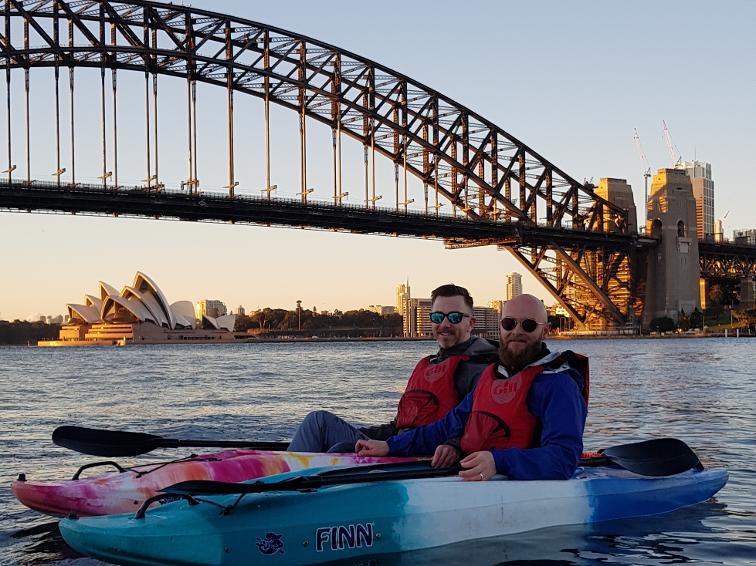
dawn kayaking amid the icons of australia
Sydney, Australia, June 2019
After a tough week at work where I’d struggled to get a decent sleep for days, pretty much the last thing I felt like doing was to be up at the crack of dawn in the Sydney mid-winter. Still, what would probably have been a wash-out of a Saturday spent recovering on the sofa turned into one worthy of a post on my blog. Sometimes the most rewarding things demand that little bit of extra effort. So, with our clothes carefully chosen the night before, a 05:30am alarm set and an Uber booked, we headed down to Lavender Bay at a time in the day when Sydney is all dark and silent and when the winter sun is only just stirring. I must admit, after having got over the early start to my normal sleepy Saturday, I do attest to the spiritual benefits of seizing the day in this way – even if it is a jolt to a tired teacher’s body. We arrived at Lavender foreshore, cleared up a booking error (which meant that our ‘kayak and coffee’ experience was, in reality, now just a kayak experience), donned on our lifejackets and were soon sliding off into the glassy waters of Lavender Bay, passing bobbing boats, dinky jetties and mooring posts. My hands were soon cold as inevitable drips and splashes ran down the paddle bar, onto my hands and all over my legs. Sydney’s ferries were not yet running and so we were able to kayak to Blue’s Point, past the iconic Luna Park fairground and, in doing so, paddle under one of the most famous bridges in the world. Four years ago I climbed over the top of it and now I was kayaking under it. With every stroke of my paddle the city sky brightened, bursting into its familiar golden glow which bounced off of the business district’s corporate glass. Heading back against the tide and firmly into the bright sunshine, we docked at Lavender Bay – distinctly cold and damp but elated that we’d done something pretty cool with our Saturday and it was only 9am…
snorkelling to post an underwater postcard in vanuatu
Efate, Vanuatu, April 2019
We headed to the Mele part of Efate to do what was, without doubt, the most touristy thing possible: posting a waterproof postcard in the underwater post office which lies twenty metres just off the coral beach of Hideaway Island - a fun little expedition made possible with the help of a return boat crossing, a GoPro underwater camera and some hired snorkel gear. Unsurprisingly this post office is the only one of its kind in the world. Unfortunately, just as in Fiji, I didn't make it off a South Pacific beach without injury. This time it was a brief encounter with a sea urchin, resulting in my spending part of that evening digging out four spines from my foot and dabbing iodine on the holes they'd left behind (unlike in Fiji we'd remembered to bring the iodine with us this time).
Click the photo above to head to my Travel Chronicle for this country.
mountain hiking along the rooftop of africa
Tsehlanyane, Lesotho, October 2018
Tsehlanyane is a national park in Lesotho's far north with incredible views of the interlocking Drakensberg-Maloti mountain range and valleys full of boulders and the culturally important berg-bamboo. We stayed in a rondavel, a Western take on the traditional African round house, overlooking the valley where mountain peaks were regularly kissed and embraced by passing clouds. A seven kilometre hike through the mountains along the wonderfully-named Lets'a Lets'o trail, crossing small streams and some cute little mountain blooms, was an energising way to spend our first morning in what some describe as the "Rooftop of Africa". At 2080 metres above sea level I found myself short of breath far quicker than I would otherwise have been but brief stops along the route to compose shots of the very photogenic landscape helped to ease the additional strain brought on by the altitude. The ever-changing weather resulted in ever-changing mountain scenery: romantic pinks and pastels one day, cloudy and stormy the next, sleet and snow the next.
Click the photo above to head to my Travel Chronicle for this country.
horse riding through lesotho's mountains
Tsehlanyane, Lesotho, October 2018
This was a wonderful experience on Lesotho's Independence Day; horse riding a few kilometres through the valley and along the tracks of the Tsehlanyane valley and one which lived up to the traveller hyperbole of being the "Rooftop of Africa". The air was fresh and the mountaintops dusted with snow. My horseriding skills have come a long way since the first time I mounted a horse back in Turkey nearly a decade before.
Click the photo above to head to my Travel Chronicle for this country.
on safari in search of africa's "big five" beasts
Pilanesberg, South Africa, September 2018
Barely rested from our marathon journey from Sydney to Jo'burg and three hour transfer to the national park, we set off on our game drive at 5:30am having had a matter of minutes to get ready - just enough time to fish my crumpled clothing out of the backpack and chuck a cereal bar down my neck as a poor excuse for 'breakfast'. Perhaps I'm being a little misleading here: my body was still running to Australian Standard Time and so, when the alarm beeped at 05:00am, it was actually lunchtime. It would take several days for my body clock to adjust to Central African Time. As it was, we crowded onto the safari jeep with a German couple and what I took to be a Croatian couple judging by their spoken language, and headed off into the park - bouncing all the way and with the fierce African sun rising to the east. We were assigned a woman called Jess as our game drive ranger. She was a tiny slip of a girl dressed in the full ranger regalia of khaki and baseball cap. She had her hair platted to the side and came with the thickest South African accent I think I have ever heard. She was as hard as nails and rather fantastic. I'd been extremely lucky in seeing the Proboscis monkeys in Brunei and the Orangutans on Malaysian Borneo that I dared not get my hopes up a third time. In travel it sometimes pays dividends to begin with low expectations; everything that subsequently goes right becomes a positively joyous experience.
However, it wasn't long before the beasts of Pilanesberg put on their best African performance. Over twelve hours spread across two days and three separate game drives, I'd managed to photograph white rhinos, zebras, cheetahs, hyenas, giraffes, elephants, antelopes, warthogs, wildebeest and the mighty lion - plus a whole host of other lesser-known creatures whose names I can't recall. Jess informed us of some of the wonderful collective nouns for some of these most African of creatures: a "dazzle" of zebras, a "tower" of giraffes. I also picked up some fascinating facts about animals that only a ranger would know: animal tracks always lead to water; anything you see a monkey eating humans can eat too (because of our genetic similarities); many animals have stripes to dazzle and confuse their predator thus aiding their escape. In our little jeep we had two fascinating close shaves where two of the big five, elephants and lions, got up a little too close for the comfort of our Croat friends, one of whom let out a squeal of terror when the elephant approached - a squeal Jess shut down as soon as she heard it.
Click the photo above to head to my Travel Chronicle for this country.
trekking through virgin rainforest on borneo
Ulu Temburong, Brunei, Borneo, April 2018
Our journey across to Temburong was a long one, starting with a transfer to the Brunei River, a boat journey to the regional capital Bangar, a transfer to Batang Duri and a cruise in a traditional long boat through the shallow waters of the Temburong River. In entering Temburong we embarked on a trip through the most pristine virgin rainforest left on Borneo. Brunei's oil wealth has meant that it has not had to resort to deforestation for the contentious production of palm oil - a feature of the Malaysian part of the island which is threatening the survival of precious species, most famously, but not limited to, the endangered orang-utan. Temburong is protected, with almost all of it open only to scientists. We would trek through the tiny fraction of Temburong only open to a limited number of visitors so as to minimise the impact on the environment.
The real work started when we arrived at the entrance to the national park; an upward climb to over 1000 steps in the heat and humidity of a rainforest meant that, by the time we reached the top, my shirt was wringing wet with sweat. We then set about climbing the sixty metres of the canopy walking frame affording us a panoramic view above the tree tops and out across this virgin rainforest. I was standing looking out across the trees at almost half a kilometre up from the rainforest floor. Later we were to cool off underneath the cascades of one of Temburong's many waterfalls. The waterfall's pool was home to the so-called Borneo Piranha, which nibble away at the dead skin of anyone who happens to be bathing therein. Although completely harmless, I just couldn't get used to the sensation of having fish nibble at my body and so, having well and truly cooled off from the earlier ascent to the rainforest canopy, and having screamed like a banshee at every fishy nip, I clambered out to the safety of dry land - much to the amusement of our guide.
Click the photo above to head to my Travel Chronicle for this country.
walking along the great wall of china
Mutianyu, China, January 2018
A trip to Beijing is a golden opportunity to walk along the famous Great Wall of China and, from Beijing, there are two main options: Badaling (at 80 kilometres north of the city it is the nearest but also most visited and therefore the most commercialised section) and Mutianyu (further outside of the city with less visitors). I am very glad we ended up at Mutianyu (by default rather than by design) because, off season and harder to get to, there were times when we had entire stretches of the wall, between its 26 Ming-era watchtowers, entirely to ourselves. Aside from a group of Americans, an Italian couple and, bizarrely, a stray cat, we walked the 3 kilometre stretch of Mutianyu without much human traffic to spoil the experience. The beige blocks of the wall snake up the taupe-coloured scrub of the mountainside and, set against the deep purples of the wider mountain range in the distance, cut a dramatic sight; this stretch of the Great Wall in winter is a travel photographer's dream. Mutianyu is a rare chance to photograph an iconic wonder of the world without half of humanity being there with you. Of course, I never expect to have such places like this to myself when travelling - it's just great when luck goes your way and it's just you + camera + world wonder.
Click the photo above to head to my Travel Chronicle for this country.
kayaking the circumference of a fijian island
Kandavu Island, Fiji, July 2017
Okay, so Kandavu was a pretty small island. Still, kayaks were free to borrow and so our final afternoon was spent kayaking around the entire circumference of this little slice of paradise; lazily we went in the direction of the current rather than actually enter the realm of real physical exertion and the waves pretty much did half the work for us. We were on holiday after all.
Click the photo above to head to my Travel Chronicle for this country.
snorkelling among the corals of the south pacific
Kandavu Island, Fiji, July 2017
Above water, Kandavu is beautiful and many people's perception of what paradise is - but underwater Kandavu is magical. Taking full advantage of the free loan of snorkelling equipment from the resort's boat shed and a newly-purchased GoPro underwater camera, we headed out to the coral reef to see what lurked beneath the wobbly cobalt of the South Pacific. Snorkelling took a bit of getting used to but once I'd mastered the art of breathing only through my mouth and sounding like an aquatic Darth Vader, I began to enjoy this colourful coral world with its population of fish of all shapes and sizes. There were also sea cucumbers and, amazingly, deep blue starfish the size of my hand. The stinging coral cuts to my feet, which later became infected with marine bacteria and required both a course of antibiotics and anti-fungal cream to get rid of, were the relatively low price to pay for witnessing these underwater marvels.
Click the photo above to head to my Travel Chronicle for this country.
feeling the heat at azerbaijan's mountain of fire
Absheron, Azerbaijan, January 2018
The following day we headed out to the Abseron Peninsula to tick off two remaining sights: the Atesgah Mebedi, or Flame Temple, and the remarkable Yanar Dag, or Fire Mountain. Yanar Dag is a mountainside which, because of its location above natural gas deposits, has been shooting flames ever since a shepherd discarded a cigarette there back in the 1950s. For the second time in twenty four hours, Azerbaijan had surprised and stunned me with something straight out of Science Fiction. And the entrance fee for beholding such an incredible, once-in-a-lifetime sight? Two Manats (around £1). Our journey back from Yanar Dag was punctuated by the nodding donkey heads of oil derricks; whilst understated and sculptural individually, when clustered together in their hundreds, they cut an awesome, melancholy sight on the horizon.
Click the photo above to head to my Travel Chronicle for this country.
climbing active mud volcanoes in eastern azerbaijan
Absheron, Azerbaijan, January 2018
Setting off further south from the Petroglyphs our taxi driver, driving one of Baku's boxy Hackney carriage taxis, pulled over at the side of the motorway where we swapped vehicles. We were handed over to a giant of a man whose tiny white Lada was to be our chariot along the dangerous quagmire of a mud track and up the mountainside to the volcanoes themselves. Driver Number One also joined us in the Lada, sitting in the passenger seat whilst we squeezed in the back. We had previously been told that a 4WD was the only vehicle capable of tackling the treacherous route. So why were we sat in a Lada? Answer: because locals know that only a Lada is small, light and nimble enough to make it through the mud and up the slippery mountain. The laws of gravity dictate that the heavier the vehicle, the quicker they'll sink. Indeed, some unfortunate souls we passed along the route had done just that, including a group of Russians who were forced to abandon their car and instead head up the mountainside on foot (one man choosing to walk barefoot rather than ruin a perfectly decent pair of shoes). Our Gentle Giant Lada driver was superb at handling the car, thrusting its wheel left, right, left again to avoid getting bogged down in the mud. The car skidded and bounced and, at a number of points, I thought that perhaps we should have heeded the warnings voiced back in Baku; I had visions of having to get out of the car to help dig it out. But he knew what he was doing and any fears I had about being in a car I'd initially deemed completely inappropriate soon evaporated. Expert driving, combined with the trusty machinery of a Soviet-era tin can on wheels, meant that after a few touch-and-go moments we had made it along the makeshift track and onto the mountain plateau, home to one of the strangest sights I have ever clapped eyes on: a collection of conical shapes, some metres high, bubbling and coughing their thick grey liquid and shooting the odd flame up into the air. The volcanoes were all rather astonishing in themselves but set amid an eerie lunar landscape, encircled by a 360° mountain range, and topped with a deep blue sky, was truly unbelievable. It was one of those moments when you pause and think to yourself, "aren't I lucky to be seeing this?"
I was hopelessly ill-prepared for the challenges this fantastically muddy landscape posed: the thick mud sucked and pulled on my trainers at every step. I tightened the laces as much as I could, preventing them from being completely left behind in the deep, inevitable squelch of my next step. It didn't matter that my trainers were ruined - the Mud Volcanoes were truly worth the sacrifice. Bizarrely, Driver Number One, the most ill-equipped of us all, joined us among the bubbling volcanoes wearing his formal black leather shoes, seemingly having been overcome with as much excitement as our own, leaving the dignified safety of where the car was parked and taking to scrambling over the mud cones along with the rest of us. We were all reduced to children that day. Standing on top of a gurgling mud volcano I surveyed this most Science Fiction of landscapes, one which was, rather incongruously, disrupted by the presence of three white Ladas parked in the mud below and positioned at disconcerting angles. We were a million light years away from Baku. And it was great.
Click the photo above to head to my Travel Chronicle for this country.
outdoor adventures in new zealand's fiordland
South Island, New Zealand, January 2017
The words "stunning", "wonderful" and "beautiful" are much overused in travel writing and, in many cases, misapplied. I always try hard to avoid this kind of travel blog cliché but, in the case of New Zealand, the words are positively insufficient. Indeed, the further south in New Zealand we travelled the more beautiful and awe-inspiring it became. I firmly believe that beauty can be found in any country should you wish to look for it. You have to look harder in some places than in others but it is there. In New Zealand, however, you don't have to look very hard. The diversity of its natural wonders is beyond anything I have ever seen.
Basing ourselves in the sleepy village of Whataroa and then the townships of Alexandra and Te Anau, we set out to see the South Island's most incredible natural wonders, starting with a hike through the Westland Tai Poutini national park, itself photographically-worthy with its vistas and waterfalls, to see the Franz Josef Glacier. Having hiked on, and abseiled up and down, glaciers in Iceland we didn't feel the need to go hiking on this particular block of ice - nor the taking of the obscenely extravagant option of flying over it in a helicopter (New Zealand seems to want to flog helicopter rides to tourists like it's going out of fashion). As it was the glacier was a great sight - especially when juxtaposed with the tropical-looking fern trees in the foreground. Our drive southward along the West Coast took us past the dazzlingly blue Lake Wanaka and Lake Huwea. Our next stop involved a slight detour west to Omarama to see the Clay Cliffs, tall pinnacle rock formations, with a blue hue, which cut a jagged outline against the sky. A little further southward took us to the snow-capped Aoraki mountain range (colonial name: Mount Cook). A hike through to Kea Point gave us the best possible side-on view of the famous mountain without the need to undertake a serious mountain expedition in the footsteps of Sir Edmund Hillary! Further southward into Fiordland at Te Anau brought us tantalisingly close to the majestic Milford Sound (Piopiotahi), an iconic composition of interlocking mountains and the highlight of many a person's visit to New Zealand's South Island. We arrived early to avoid the tourist hordes who we knew would be winging their way on scores of coaches from 8am onward. We took a two hour cruise to get up close an personal with this famous fiord's waterfalls and seals but, perhaps ironically, I managed to capture a stunning photograph of Milford Sound from the car park. It is, quite arguably, the best photograph I have ever taken: the purple moodiness of the peaks are reflected perfectly in the fiord's morning tide. This just goes to show that often the best views to be had are ones that are free - no need for expensive helicopters or even the considerably cheaper boat cruise. Our scenic return drive back from Milford Sound included stop offs at The Chasm, the Mirror Lake and a walk through the gob-smackingly beautiful rainforest and alpine lake of Lake Marian.
Click the photo above to head to my Travel Chronicle for this country.
snorkelling in the gulf of oman
Gulf of Oman, Oman, May 2015
The Gulf of Oman isn't just home to a playfully-large incense burner which sits on top of a large hillside overlooking the Gulf, but also pods of dolphins. For a bargain price we went on a dolphin watching cruise with Sidab Tours along with a bunch of other tourists. It was intensely hot and I was a bit concerned about being out on the ocean in the morning sun waiting for hours just for a glimpse of the odd fin or tail - especially with the overheating episode from the previous daystill fresh in my mind. However, my fears were unfounded; within seconds of arriving in the dolphin-inhabited waters, pods of the majestic creatures put on a wonderful display for us, zooming alongside the boat and jumping out of the water. I wasn't sure the day could get any better. It did. Having captured a few great photographs of the dolphins above the water, a couple of hours snorkelling gave me a chance to see what was below the surface. It was the first time I'd been snorkelling and loved swimming through schools of fish, seeing the coral reef and the vicious spikes of sea urchins. Okay, so it wasn't the Great Barrier Reef exactly, but it was still great. This underscores a key point about travel in this region: there are infinite possibilities for doing something rather special outside of the city. Dolphin watching and snorkelling in the Arabian Gulf accounts for the best forty quid I've ever spent!
Click the photo above to head to my Travel Chronicle for this country.
climbing the sydney harbour bridge
Sydney, Australia, August 2015
Our first morning in Sydney was spent sleeping off the very worst of the jet lag caused by a nine-hour jump forward to Australian Eastern Standard Time (AEST) and a full 24 hours of travelling inside an aluminium tube at 40,000 feet. The afternoon comprised of an impatient walk, fuelled by the kind of nervous excitement only a traveller who has just landed in a new country can appreciate, down to Sydney's famous Harbour with its iconic Harbour Bridge and even more iconic Opera House. A short return ferry ride out to Kirribilli afforded us advantageous views of both. In the back of my mind I couldn't help but brood over the fact that in half a day's time I'd be climbing to the top of one of them...
The Sydney Harbour Bridge is the largest single span arch bridge in the world and was, incongruously, designed by a company in Middlesbrough, United Kingdom. For around £150, and by booking well in advance online, you can climb over the top of the bridge's famous iron arch, known locally as 'the coathanger'. It just so happened to be my birthday, too. Viewing the famous Sydney Opera House and the glittering towers of Sydney's CBD from a unique 360 degree standpoint was a pretty special way to spend my birthday - one spoiled marginally by the forceful whacking of my head on one of its unforgiving steel girders. Unfortunately this would not be the last stupidity-induced injury I was to suffer on this, my first journey Down Under.
Click the photo above to head to my Travel Chronicle for this country.
waterfall swimming in central cuba
Cienfuegos, Cuba, December 2014
The road to El Nicho national park was not exactly plain sailing. Our Cubataxi displayed a red warning light on the dashboard almost from the moment we set off from Casa Ines Maria in central Cienfuegos. Within minutes of climbing up the hillsides to reach El Nicho the driver pulled over in the hope the engine would cool. It didn't. The driver hot-footed it to a nearby garden to fill his large plastic bottle with water, which he poured all over the engine. Ten minutes later another stop. Memories of my journey in the Morocco death taxi replayed in my mind... This time water from a stream. Bonnet up. Pouring of water. Steam. Would we get there? We did. But only just. The principal attraction of El Nicho is its waterfall - and rightly so. It was wonderful. The route you walk in the park isn't that long but it's stuffed full of weird and wonderful-looking plants, a few of which bore a remarkable resemblance to some of my house plants back in the United Kingdom. Getting changed into swim shorts in the middle of the forest to stand under the waterfall and have a splash around in its pool was completely memorable.
Click the photo above to head to my Travel Chronicle for this country.
yurt-staying & horse riding 3012m above kyrgyzstan
Son-Kul, Kyrgyzstan, August 2014
We did what everyone must do when in Kyrgyzstan - sleep in a yurt on a mountaintop. Our destination was Son-Kul. Son Kul is a large mountain lake on the top of a plateau 3016 metres above sea level - and, after a couple of hours, I began to feel a little compressed as if my head was in a vice, such was the air pressure at this altitude. Indeed, the plastic ball on my roll-on deodorant popped out and flew across the yurt. An ongoing headache soon kicked in and, to be honest, I was glad of the descent down the mountain slopes the next day. Weather can be unpredictable at this high altitude and we soon found ourselves donning all the clothes we had to keep warm. Son-Kul is also the location of a community-based tourism project offering yurtstays to foreign tourists. Not ones to pass up the chance of doing something out of the ordinary, we booked an overnight stay on the mountain, roughing it in a yurt as well as doing some horse riding.
The Son-Kul plateau is surrounded by snow-capped mountains - a dramatic landscape in which to go horse riding with the shepherd. He spoke very limited English, only saying "cold, cold!" when referring to the change in weather and "lunch!" when one of our horses would stop to eat grass. He had one of the most characterful faces I have ever seen; deeply cut wrinkles a feature of high-altitude and a life spent outdoors, all of his bottom teeth were missing (apart from two) and his upper teeth were all gold - a feature I found to be quite common across Central Asia. Indeed, seeing mouths full of golden teeth was a frequent sight on my journey around this region. Occasionally our shepherd would stop to pick plants and vegetation, stuffing it under the saddle of his horse to take back to camp. Having ridden horses, camels and elephants before, I took to riding this latest beast easily. A couple of hours later it was too cold on the mountain to go any further and, with our horses dragging us into the lake for a quick drink, and with the two dogs which had been play-fighting around the feet of our horses the whole trip finally tiring of their exertions, we headed for dinner with the family. Thankfully the shepherd's wife had prepared the fire during our horse ride adventures and so we returned to a warm and cosy yurt. Brushing our teeth took place with the help of a bottle of mineral water and a makeshift sink sticking out of the ground in the middle of the plateau. The toilet was a metal shack with a hole in the ground. It stank to high heaven. I decided to hold everything in until we reached our hotel back in the Kyrgyz capital rather than use the thing. I wasn't to know then that I would be spending a little more time in the loo back in Bishkek than I had originally anticipated - more of this later. The second day started with a bump - up early, a shepherdess-cooked pancake for breakfast and then a quick descent down the mountain - the views to and from to Son-Kul are truly stunning and were, undoubtedly, one of the highlights of this leg of the journey.
Click the photo above to head to my Travel Chronicle for this country.
hot air ballooning above burma's iconic pagoda plain
Bagan, Burma/Myanmar, December 2013
Bagan is famous for its ancient pagoda-covered landscape and, along with Lake Inle, is the must-see sight for anyone visiting Burma. Better still, to experience Bagan in sufficient depth you have to see the pagoda landscape at sunrise or sunset - or, indeed, both. We went one better by booking a hot air balloon ride at sunrise on New Year's Eve with Balloons Over Bagan, a company with an unblemished reputation and whose pilots are all British (BoB is the single biggest employer in the city). Being a sanction country meant that paying for our tickets was a labyrinthine, Kafka-esque affair involving, as it did, a telegraphic transfer to an intermediary bank in Singapore. The balloon rides were not cheap, either. As part of the deal we had transfers to and from our hotel in the Nyaung U township of Bagan, coffee and biscuits on arrival (in the middle of a field in the dark), champagne and croissants on touchdown, as well as a photograph taken high up in the air by a camera suspended on ropes.
The view of Bagan's old pagodas at daybreak from our unique balloon basket vantage point was incredible. The landscape drifted by in slow motion, accompanied by the calming sounds of the basket's rhythmic creaking. We drifted as high as 1400 feet and as low as a few hundred across the pagoda plain and over the Ayerwaddy River - the river we had sailed down only the day before. Local villagers tending to the land, and kids playing, waved up at us as we passed overhead - their subsistence life on the ground admittedly an uncomfortable contrast with the expensive, frivolous V.I.P. balloon ride I found myself enjoying. Our pilot was called Peter, an experienced balloon pilot of fifteen years. We were also joined by two American couples and a couple from China. Despite my abject fear of flying in airplanes, going up in the balloon felt completely safe. Our landing was, thankfully, a textbook one - bending our knees and gripping two rope handles embedded in the weave of the basket, there was an unremarkable bump as we glided to the ground. This was quite clearly the best way of sampling the Bagan landscape in all its magical entirety - expensive but, as I reasoned at the time, I was only going to be in Bagan once in my life. Often money gets in the way of travel. The important thing in travel is to realise when it shouldn't.
Click the photo above to head to my Travel Chronicle for this country.
illegally entering an abandoned communist hq in bulgaria
Peak Buzludzha, Bulgaria, August 2013
Buzludzha is some 250 kilometres south east of Sofia. Public transport does not lend itself to travelling to this place as so few people actually want to go here. It features only nominally in the Lonely Planet Rough Guide to Bulgaria - one paragraph, in fact. You could be forgiven for missing this destination out entirely because you didn't even know it existed. You won't find this building on any Bulgarian postcard or in any Bulgarian brochure. It is home to one of the most bizarre and curious sights ever built. Many Bulgarians despise it. The Prime Minister wants it demolished - if only they had the money to do so. It stands forlorn and abandoned high up on a hilltop, a cosmic, concrete externalisation of a failed socialist system which Bulgaria is keen to shuffle off into the vaults of time labelled "Forget". It is the Mount Buzludzha UFO building, a once grand concrete meeting place for communists. Politics aside, it is one of the most marvellous examples of cosmic communist architecture there is and acts, I believe, like a touchstone to the ideology and period which built it. For this reason alone it should be preserved. It is a little trite to say that the state of the building is a perfect metaphor for communism itself - but I suppose that's what it has become: like communism, the building was cheaply executed, illusory and full of obscene hyperbole and, ultimately, completely unsustainable. Marooned on a hilltop, and an uncomfortable relic reminiscent of a darker Bulgarian past, it has been handed over to the Socialist Party of Bulgaria - which has failed to do anything with it except lock its doors and leave it to rot. Except, as you'll see below, they even failed to secure the building fully. I managed to get inside.
Recording my entry on camera as I picked my way through the rubble, illuminated by the torch, I made it to the central auditorium - with a jaw-dropping 360 degree mosaic all around featuring communist motifs and symbols: clenched fists, red stars, unified groups of workers, geometric patterns and portraits of three communist visionaries Marx, Engels and Lenin. Artistically it is magnificent. Above my head was a huge hammer and sickle symbol on what was remaining of the ceiling, through which daylight was now streaming. To say it was an eerie experience is an understatement but I feel really, really lucky to have seen it; the condition it is in means that it is unlikely to last much longer. Buzludzha was an incredible end to the journey we started over a fortnight earlier on the safe, civilised Croatian coast. Coincidentally, on arriving back home in the United Kingdom, my copy of Lonely Planet Magazine was waiting for me on the doormat. As part of its 40th anniversary celebrations, it featured a trip to...Mount Buzludzha.
Click the photo above to head to my Travel Chronicle for this country.
rafting along the tara canyon from montenegro to bosnia
Scepan Polje,Bosnia & Montenegro, August 2013
Our last day in Montenegro saw us travel back up north to the Bosnian border to do what many do when in this country: rafting along the awe-inspiring Tara Canyon. We left early to make it back up north in time for the big rafting adventure. I'd heard that Tara is deeper than the Grand Canyon in the United States but did not believe it. On seeing the canyon when we first entered Montenegro, I was left thinking that there was a fair chance that it was true! In fact, it's the second deepest canyon in the world. With almost no instruction, and with complete disorganisation, we were piled onto our raft - and set off tentatively perched on the side of the raft's inflatable sides, hooking our feet in the elastic cables on the raft's base. A couple of times, hitting the rapids, I thought we were going in - there was so much water flying about. I am not known for my "whooping" and despise anyone using or writing the word. I am British and therefore do not get carried away but prefer to smile. However... The rapids were truly exhilarating and even had me "whooping" uncontrollably. These crazy rapid episodes were interspersed with long periods of drifting lazily down the canyon in the sun, the others sharing fags and cans of lager which we were also offered. There were eleven of us on the raft - two Americans, us, and the rest were Serbian - all very friendly enough despite the language barrier. Two girls were particularly funny, perched on the raft's back with a fag and can of beer in each hand, not doing any rowing and shouting in English "Row, come on muscles!" They also translated the instructions from our Serbian lead rafter, who had taken to laughing and drinking like a duck to water. How these girls held on I have no idea and I forgave their laziness because they were friendly and funny.
We were collected from Podgorica at 7am, exiting Montenegro and back into Bosnia to start at the rafting camp. We were then whisked along toe-curlingly dangerous roads in an open-door minibus back into Montenegro to the spot where we'd launch the raft into the Tara. We rafted 25km of stunning Tara canyon, and re-entered Bosnia Herzegovina yet again as we did so - passing the checkpoint up on the mountain road above. I thought I'd only be going to Bosnia & Herzegovina and Montenegro once. Technically I went to both three times! I can also say that I have been white water rafting in both countries! The food back at Tara camp in Montenegro was hearty and home-made - all cooked fresh and a vegetarian dish was made especially for us with no quibble. It was a long, sweaty journey back to the capital Podgorica where we had a bed reserved at the Montenegro Hostel - slap bang in the middle of a run down housing estate encrusted with political graffiti declaring 'Kosovo je Srbija' (Kosovo is Serbian). The only reason we stayed here was because it would then allow us to use the hostel's transfer bus into Tirana, Albania - a snip at €35 each. There are no public trains or buses from Montenegro into Albania so this was our only option. The hostel was run by a lovely woman called Maya who did all she could to help and spent the time laughing and joking with us about Montenegrin and British habits ("oh, of course you are British - I like you as you are black and white, you say yes or no. In Montenegro they don't commit" and "Montenegro time is always later than planned - we are always late...") I tried to be polite by stating that Podgorica was "interesting" even though there was not much to do. Her response was "no it's not - and I was born here". She was memorable because she was honest, intelligent, ballsy and fun and I liked her a lot: she was one of the real characters we met on the trip.
Click the photo above to head to my Travel Chronicle for this country.
husky dog sledding in an icelandic snow storm
Mýrdalsjökull, Iceland, February 2013
A truly wonderful experience was the husky dog sled on the slopes of Skálafell, a place which lies at the foot of one of Iceland's glaciers. We left a grey and drizzly Reykjavik and, forty minutes later, were in the midst of an almost complete snowy white-out, with howling huskies adding to the sense of isolation and white wilderness. Cue flashbacks from films where people get stranded and have to do everything to survive in the unforgiving weather. It was a shock to go from capital city to snowblivion in such a short space of time. Even having tried to dress appropriately for the occasion, I was woefully under prepared and was hugely thankful of an offer of an additional pair of waterproof overalls from our guide. Here's a tip to make sure you are well-prepared for the ruthless Nordic chill of Iceland: wear everything you think you need - then double it. Having acquainted ourselves with the dogs, and having donned extra winter protection in the form of a plastic onesie, we set off into the snow with Rolf, a happy-go-lucky twenty-something Dutchman with a love of huskies. We had six husky dogs pulling the three of us several kilometres on the slopes 50 kilometres above sea level. Rolf called our location "Fog Mountain" - and with just cause. Going husky dog sledding was simply awesome. I even made special friends with a female husky called Oskar who liked to lick my nose and lift her paw into my hand as if forbidding me to leave. Our lead husky was a lovely black bear-like dog called Manitock. Although pricey at around £115 each, the sledding was worth every Krona.
Click the photo above to head to my Travel Chronicle for this country.
climbing up & abseiling down a glacier in iceland
Mýrdalsjökull, Iceland, February 2013
Travelling with Arctic Adventures, we hopped onto a minibus destined for a glacier some two hours' drive south-eastward, once again leaving the chilly but sedate weather behind in Reykjavik and heading straight into the mists and snow. During the winter months in Iceland any increase in altitude in winter goes hand in hand with an ascension into thick fog. Huge mountain tops evaporated into the clouds. Dóri, one of our guides, duly informed all thirteen of us, as we sat there in the bus blinking at him with expectant anticipation, that we were hiking on a glacier close to the active Volcano Hekla - which was "overdue" an eruption. Hekla is also Iceland's second most active volcano and in Medieval times was believed to be the actual entrance to hell. Gulp. Dóri also referred to several places whose names were tongue-twistingly crazy and equally unpronounceable. We drove to the edge of the Mýrdalsjökull glacier located close to Iceland's south coast: it had a distinct and intriguing blue tinge to it. Apparently the Mýrdalsjökull glacier moves 15 centimetres a day along the valley. Kitted out with crampons, a harness, ice pick and helmet we soon hit the ice. However, nobody told me we'd be climbing up and abseiling down a glacier as part of the trip. Still, I did it, although coming down was harder than going up owing to my complete inability to follow simple instructions. Using two ice picks, one in either hand, and punting my spikes into the wall of ice, I managed to get myself to the top.
Click the photo above to head to my Travel Chronicle for this country.
hiking the kasakh gorge in western armenia
Aragatsotn, Armenia, August 2012
It's always nice to find that you have a spare day on your travel itinerary to do with whatever you fancy. We opted to do something a little bit different feeling driven, as we were, out of Yerevan by the heat. We opted for the Embracing Armenia tour run by the Envoy Hostel in central Yerevan. For 13,000AMD (£20), we were taken to the top of Mount Aragats.
Throwing caution to the wind we also opted, despite the heat, to do the hike from Amberd to Byurakan village via the gorge at Kasakh. Indeed, when we'd boarded the coach I had no idea that hiking was even a remote possibility and, as a result, neither of us were dressed for the experience. Nevertheless, sometimes in travel it's best just to go with the flow and see where it takes you. Well, in this instance, it took me across rugged Armenian grasslands with sightings of rare flowers and awesome gorge views. Embarking on this spontaneous experience means that I can now declare that I've been hiking in Armenia.
Click the photo above to head to my Travel Chronicle for this country.
camel trekking through a jordanian desert
Wadi Rum, Jordan, February 2012
Wadi Rum, a desert in southern Jordan bordering Saudi Arabia and made famous by Lawrence of Arabia who travelled through here, was the final destination on our journey around Jordan. We had arranged, through a series of emails back and forth, to stay overnight with a family of Bedouin in their camp. This was true adventure travel. Not long after our arrival we were bundled into the back of a green Jeep to begin our tour of the desert; incredible rock formations, ancient petroglyphs, giant sand dunes and vertigo-inducing rock bridges. The vivid burnt orangey reds of the desert and otherworldly rock shapes were almost lunar in semblance. And, apart from one group of travellers we came across briefly, it was a desert we seemingly had entirely to ourselves - save for the odd rock lizard and lost black camel lolloping aimlessly by.
We awoke to a misty and evocative desert scene the next morning. Throwing open our tent window we savoured the view of a desertscape which was perfectly still, perfectly silent. A less than satisfactory breakfast comprised of stale breadsticks and a near-finished jar of jam awaited us and would have to suffice as sustenance for our long, slow camel trek out of the desert to begin our journey back up north to the Jordanian capital.
Click the photo above to head to my Travel Chronicle for this country.
climbing the burdah rock bridge in southern jordan
Wadi Rum, Jordan, February 2012
After a day exploring the very best of desert life, which included a sweaty walk through a giant gorge, clambering up to and walking across the great Burdah Rock Bridge as well as running up and down sand dunes, we retired to the relative comfort of our tent at the foot of a mountain. This being off-season, we had the entire camp to ourselves. As many travellers will attest, desert temperatures drop dramatically at night. This being February the temperatures hovered around a few degrees at night meaning we had little option but to take full advantage of the plethora of thick blankets available in the tent. Indeed, we found ourselves using them all - the downward weight of which, when one was underneath, bordered on the oppressive and claustrophobic. The only thing left uncovered, and thus frozen, was my nose.
Click the photo above to head to my Travel Chronicle for this country.
cycling around a canadian city
Montreal, Canada, August 2011
What would have otherwise have been wasted time on our final morning was instead used profitably with the hiring of a bike, thanks to the city's Bixi public bike system. Cycling under the city's imposing skyscrapers along giant boulevards on a sunny morning was thrilling, if not a little hair-raising at times. I clearly took a few risks I shouldn't, having not been on a bike for some time. I received a few car horn beeps but am glad to say that I lived to tell the tale...
Click the photo above to head to my Travel Chronicle for this country.
climbing the highest mountain in england & wales
Snowdonia, Wales, August 2010
The English name "Snowdon" comes from the Saxon Snow Dun, meaning "snow hill". More ominously, the Welsh name for Snowdon, "Yr Wyddfa" means "The Tomb" - an etymological fact likely to have the less-experienced climbers out there reconsidering their climb altogether. Aside from the company of thousands of other climbers scrabbling on rocks and posing for photographs all around you, your journey up and down Snowdon is punctuated by a series of perfectly still, and beautifully blue, llyns - or lakes in English. Leaving from Pen-y-Pass to follow the Pyg Track, we passed no less than four lakes, the most special of which was Llyn Llydaw. In fact, the scenery is so special in places, with peaks, lakes and other geographical features all interacting in a kind of landscape kaleidoscope, that our seven hour trek (up and own) was extended as photography became positively obligatory. Having made many trips to the "Land of the Red Dragon", from Anglesey in the north to Cardiff in the south, climbing Mount Snowdon was undoubtedly the peak, metaphorically but of course also literally, of my time in Cymru.
Click the photo above to head to my Travel Chronicle for this country.
camel trekking through palm groves in morocco
Marrakesh, Morocco, February 2010
We decided to escape the freneticism of central Marrakesh by booking a half-day camel trek in the Palm Groves, some twenty kilometres outside of the city. It was sufficient a distance as to help us pretend we were a world away. We spent our day with two Americans, a guide who spoke no English but whose smile made up for it, and a camel called Ali Baba. This leg of the journey revealed a more tender, easy going side to Morocco which I would not otherwise have seen. Lolloping through palm forests in the Moroccan countryside on camel back was a wonderful way to while away the best part of a day, stopping only to enjoy some Mahgreb mint tea served, notably, by a characteristically high pouring position. Our American friends headed back to their five star hotel on the edge of town with cable TV...and we headed back into the Jemaa el Fnaa. Admittedly I was a little envious of their luxury but we had made our choice to keep it local (and budget) and had to stick with it. I would have killed for a hotel room with a few modern conveniences and hot running water. A room without mould on the walls would have been awesome too.
Click the photo above to head to my Travel Chronicle for this country.
horse riding through the countryside of central turkey
Cappadocia, Turkey, May 2009
After a unique take on paella at the French pensione, and a much-needed rest, we awoke the following morning for something even more adventurous: horse-riding. We met up with a pint-sized local man for a journey through the Cappadocian countryside. Although pleasant and getting to see some more of the countryside in central Turkey, the trek was some five hours long and, by the final hour or so, I was in great pain. Indeed, took its toll on my ability to walk normally afterwards. On the final night, we walked up the steep incline of Uchisar Hill, also known as Cappadocia Castle, to watch the sun set over Cappadocia. At 1350 metres above sea level, we were quite frozen by the time the sun had finally set. The sun setting and juxtaposed against the dramatic outlines of Uchisar Hill was a fitting end to our time in Turkey.
Click the photo above to head to my Travel Chronicle for this country.
travel tips, links & resources
- Doing something more active abroad firmly takes you out of the ordinary and well-away from the relative safety and banality of typical tourist traps. Active travelling offers you the chance of an extra buzz, a chance to see the landscape and, more often than not, a chance to share the experience with other like-minded travellers from all over the world who, like you, are up for a bit of something different or just there to tick off the bucket list.
- Getting active abroad is one of the best ways to by-pass all of the tourist confectionery. Break free from the mould, bypass the tourist hordes and escape from the sanitised city by organising an excursion before you set off. You'll be glad you did.
- Away from the safety of the hotel room, pretty much most things can go wrong - even more so if you're engaged in something more active than just sightseeing. Therefore, it's important to check what your insurance covers you for when abroad before you set off.
- It is worthwhile ensuring you take with you a small first aid kit on any active day experiences. There have been countless times when we've either been without one entirely or have remembered to pack it - only for it to not have in it the things needed at the time. Iodine is worth consideration - especially if you are taking part in any underwater activities; marine bacterial infections can get very nasty (as I was to discover).
- I try to avoid booking myself on any excursions which revolve around many people being on a bus. Try to organise a 'private' experience as far as possible as, in my experience, this maximises your enjoyment.
- Read up carefully on any company with whom you are placing your safety and wellbeing. Obviously, online reviews are a good place to start. Consider: what is their feedback score? Are the reviews suspicious or genuine? How long have they been operating? What awards or accreditations do they have?
you may also like

